Free Online FOOD for MIND & HUNGER - DO GOOD 😊 PURIFY MIND.To live like free birds 🐦 🦢 🦅 grow fruits 🍍 🍊 🥑 🥭 🍇 🍌 🍎 🍉 🍒 🍑 🥝 vegetables 🥦 🥕 🥗 🥬 🥔 🍆 🥜 🎃 🫑 🍅🍜 🧅 🍄 🍝 🥗 🥒 🌽 🍏 🫑 🌳 🍓 🍊 🥥 🌵 🍈 🌰 🇧🇧 🫐 🍅 🍐 🫒Plants 🌱in pots 🪴 along with Meditative Mindful Swimming 🏊♂️ to Attain NIBBĀNA the Eternal Bliss.
Kushinara NIBBĀNA Bhumi Pagoda White Home, Puniya Bhumi Bengaluru, Prabuddha Bharat International.
10/12/21
Filed under: General, Theravada Tipitaka , Plant raw Vegan Broccoli, peppers, cucumbers, carrots
Posted by: site admin @ 7:17 am
Posted by: site admin @ 7:17 am
𝓛𝓔𝓢𝓢𝓞𝓝 4120 Wed 13 Oct 2021
Do Good Purify Mind - Path to Eternal Bliss

Mindful Swimmer Lavender Awakened CMJC
Shared with Public
Hunger is the worst kind of illness said Awakened One
Grow Broccoli


tiny Carrots
Fruit




fruit bearing trees


vegetables and fruits and all over the world and in space.


- Online Positive Universal Prabuddha Intellectuals Convention.
Online Positive Universal Prabuddha Intellectuals Convention.
 Online Positive Universal Prabuddha Intellectuals Convention.
Online Positive Universal Prabuddha Intellectuals Convention.Wake up at 03:45 AM
After Bath Practice Patanjali Yogic Meditation From 04:00 AM to 05:00 AM at
𝙆𝙪𝙨𝙝𝙞𝙣𝙖𝙧𝙖 𝙉𝙄𝘽𝘽Ā𝙉𝘼 𝘽𝙃𝙐𝙈𝙄 𝙋𝙖𝙜𝙤𝙙𝙖
18𝙛𝙩 𝘿𝙞𝙖. 𝙖 3𝘿 360 𝙙𝙚𝙜𝙧𝙚𝙚 𝙘𝙞𝙧𝙘𝙪𝙡𝙖𝙧 𝙋𝙖𝙜𝙤𝙙𝙖 𝙖𝙩
𝙒𝙝𝙞𝙩𝙚 𝙃𝙤𝙢𝙚,
668 5𝙩𝙝 𝘼 𝙈𝙖𝙞𝙣 𝙍𝙤𝙖𝙙,
8𝙩𝙝 𝘾𝙧𝙤𝙨𝙨, 𝙃𝘼𝙇 𝙄𝙄𝙄 𝙎𝙩𝙖𝙜𝙚,
𝙋𝙪𝙣𝙞𝙮𝙖 𝘽𝙃𝙐𝙈𝙄 𝘽𝙚𝙣𝙜𝙖𝙡𝙪𝙧𝙪,
𝙈𝙖𝙜𝙖𝙙𝙝𝙞 𝙆𝙖𝙧𝙣𝙖𝙩𝙖𝙠𝙖,
𝙋𝙧𝙖𝙗𝙪𝙙𝙙𝙝𝙖 𝘽𝙝𝙖𝙧𝙖𝙩 𝙄𝙣𝙩𝙚𝙧𝙣𝙖𝙩𝙞𝙤𝙣𝙖𝙡
𝙝𝙩𝙩𝙥://𝙨𝙖𝙧𝙫𝙖𝙟𝙖𝙣.𝙖𝙢𝙗𝙚𝙙𝙠𝙖𝙧.𝙤𝙧𝙜

𝙗𝙪𝙙𝙙𝙝𝙖𝙨𝙖𝙞𝙙2𝙪𝙨@𝙜𝙢𝙖𝙞𝙡.𝙘𝙤𝙢
𝙟𝙘𝙨4𝙚𝙫𝙚𝙧@𝙤𝙪𝙩𝙡𝙤𝙤𝙠.𝙘𝙤𝙢
𝙟𝙘𝙝𝙖𝙣𝙙𝙧𝙖𝙨𝙚𝙠𝙝𝙖𝙧𝙖𝙣@𝙮𝙖𝙝𝙤𝙤.𝙘𝙤𝙢
080-25203792
9449260443
9449835875
Spread the Words of Buddha from
𝙝𝙩𝙩𝙥://𝙨𝙖𝙧𝙫𝙖𝙟𝙖𝙣.𝙖𝙢𝙗𝙚𝙙𝙠𝙖𝙧.𝙤𝙧𝙜, WhatApp, Telegram,Facebook, Twitter, more than 5000 Emails.
Practicing Mindful Swimming at Dolphin Aquatics at Halasuru from 05:30 AM to 07:00 AM
IN
9+
ඔබ සිත නිරතුරුවම කාමයන්ට ඇලෙනවා නම් එකම ඖෂධය ||@Maha Rahathun Wadi Maga Osse!!!
Kosala Weerathunga
18K subscribers
*ඔබ
තුළ රාග සිත් සකස්වෙන්නේ නම් නිරතුරුවම සිත කාමයන්ට ඇලෙනවා නම් රූපයන්
කෙරෙහි ඇලී යනවනම් ගැලී යනවනම් එකම කමටහන එකම ඖෂධය “කායානුපස්සනාවයි”
තුළ රාග සිත් සකස්වෙන්නේ නම් නිරතුරුවම සිත කාමයන්ට ඇලෙනවා නම් රූපයන්
කෙරෙහි ඇලී යනවනම් ගැලී යනවනම් එකම කමටහන එකම ඖෂධය “කායානුපස්සනාවයි”
*කමටහනක් ඔබේ ජීවිතයට ලබා ගන්නා හැටි
*තමුන් සිල්පද බිඳ ගත් හැටි/ජීවිතය වරද්දා ගත් හැටි මෙනෙහි කර ගනිමිනි නිවැරදි වන ආකාරය
අති පූජණීය රාජගිරියේ අරියඥාණ හිමි
@Rajagiriye Ariyagnana Thero - සඳහම් දේශනා
———————————————————————————————————————————————————–
———————————————————————————————————————————————————–
මෙම උත්තම දේශනාව දේශනා කරන දේශකයානන් වහන්සේටත් මෙම ධර්ම දානය බෙදා හරින මා හටත්,
මෙම දේශනාව ශ්රවණය කරන ඔබටත් ධර්ම දානමය පින අනුමෝදන් වේවා !!!
To the preachers who preach this great sermon and to me who distribute this Dhamma alms,
May you who listen to this sermon also receive Dhamma almsgiving merits !!!
කෝසල වීරතුංග
@Kosala Weerathunga
———————————————————————————————————————————————————–
Watch More Videos And Subscribe Us ….. Get The Latest Dharma Sermon…
———————————————————————————————————————————————————–
Donate To Us AND “Collect Merits” :
———————————————————————————————————————————————————–
Contact :-
Kosala Weerathunga
+94772935424 ( Voice )
+94772919004 ( WhatsApp, Imo, Viber, Telegram )
+94719919004 ( Voice )
Facebook : https://www.facebook.com/kosala.weera…
Tree >> Sutta Piṭaka >> Saṃyutta Nikāya >> Khandha Saṃyutta
SN 22.8 (S iii 18)
Upādāparitassanā Sutta
— Agitation through clinging —
[upāda+paritassana]
The arising and cessation of suffering takes place in the five aggregates.
Note: info·bubbles on every Pali word
Pāḷi
sāvatthi·nidānaṃ.
English
The Sāvatthi opening.
–
upādā·paritassanañ·ca vo, bhikkhave, desessāmi
an·upādā·a·paritassanañ·ca. taṃ suṇātha, sādhukaṃ manasi karotha,
bhāsissāmī ti.
upādā·paritassanañ·ca vo, bhikkhave, desessāmi
an·upādā·a·paritassanañ·ca. taṃ suṇātha, sādhukaṃ manasi karotha,
bhāsissāmī ti.
–
I will expound you, bhikkhus, what is agitation through clinging and
non-agitation through non-clinging. Listen to this and pay close
attention, I shall speak.
I will expound you, bhikkhus, what is agitation through clinging and
non-agitation through non-clinging. Listen to this and pay close
attention, I shall speak.
– ‘evaṃ, Bhante’ ti kho te bhikkhū bhagavato paccassosuṃ. bhagavā etad·avoca:
– Yes, Bhante, answered the bhikkhus to the Bhagavā. The Bhagavā spoke thus:
–
kathañ·ca, bhikkhave, upādā·paritassanā hoti? idha, bhikkhave, assutavā
puthujjano rūpaṃ ‘etaṃ mama, eso·ham·asmi, eso me attā’ ti
samanupassati. tassa taṃ rūpaṃ vipariṇamati aññathā hoti. tassa
rūpa·vipariṇām·aññathā·bhāvā uppajjanti
soka·parideva·dukkha·domanass·upāyāsā.
kathañ·ca, bhikkhave, upādā·paritassanā hoti? idha, bhikkhave, assutavā
puthujjano rūpaṃ ‘etaṃ mama, eso·ham·asmi, eso me attā’ ti
samanupassati. tassa taṃ rūpaṃ vipariṇamati aññathā hoti. tassa
rūpa·vipariṇām·aññathā·bhāvā uppajjanti
soka·parideva·dukkha·domanass·upāyāsā.
–
And how, bhikkhus, is there agitation through clinging? Here, bhikkhus,
an uninstructed ordinary individual regards Form as ‘This is mine, I am
this, this is my self.’ For him, that Form changes and varies. With the
change and variation of that Form, there arise in him sorrow,
lamentation, pain, affliction and despair.
And how, bhikkhus, is there agitation through clinging? Here, bhikkhus,
an uninstructed ordinary individual regards Form as ‘This is mine, I am
this, this is my self.’ For him, that Form changes and varies. With the
change and variation of that Form, there arise in him sorrow,
lamentation, pain, affliction and despair.
vedanaṃ
‘etaṃ mama, eso·ham·asmi, eso me attā’ ti samanupassati. tassa sā
vedanā vipariṇamati aññathā hoti. tassa vedanā·vipariṇām·aññathā·bhāvā
uppajjanti soka·parideva·dukkha·domanass·upāyāsā.
‘etaṃ mama, eso·ham·asmi, eso me attā’ ti samanupassati. tassa sā
vedanā vipariṇamati aññathā hoti. tassa vedanā·vipariṇām·aññathā·bhāvā
uppajjanti soka·parideva·dukkha·domanass·upāyāsā.
He
regards Feeling as ‘This is mine, I am this, this is my self.’ For him,
that Feeling changes and varies. With the change and variation of that
Feeling, there arise in him sorrow, lamentation, pain, affliction and
despair.
regards Feeling as ‘This is mine, I am this, this is my self.’ For him,
that Feeling changes and varies. With the change and variation of that
Feeling, there arise in him sorrow, lamentation, pain, affliction and
despair.
saññaṃ
‘etaṃ mama, eso·ham·asmi, eso me attā’ ti samanupassati. tassa sā saññā
vipariṇamati aññathā hoti. tassa saññā·vipariṇām·aññathā·bhāvā
uppajjanti soka·parideva·dukkha·domanass·upāyāsā.
‘etaṃ mama, eso·ham·asmi, eso me attā’ ti samanupassati. tassa sā saññā
vipariṇamati aññathā hoti. tassa saññā·vipariṇām·aññathā·bhāvā
uppajjanti soka·parideva·dukkha·domanass·upāyāsā.
He
regards Perception as ‘This is mine, I am this, this is my self.’ For
him, that Perception changes and varies. With the change and variation
of that Perception, there arise in him sorrow, lamentation, pain,
affliction and despair.
regards Perception as ‘This is mine, I am this, this is my self.’ For
him, that Perception changes and varies. With the change and variation
of that Perception, there arise in him sorrow, lamentation, pain,
affliction and despair.
saṅkhāre
‘etaṃ mama, eso·ham·asmi, eso me attā’ ti samanupassati. tassa te
saṅkhārā vipariṇamanti aññathā honti. tassa
saṅkhārā·vipariṇām·aññathā·bhāvā uppajjanti
soka·parideva·dukkha·domanass·upāyāsā.
‘etaṃ mama, eso·ham·asmi, eso me attā’ ti samanupassati. tassa te
saṅkhārā vipariṇamanti aññathā honti. tassa
saṅkhārā·vipariṇām·aññathā·bhāvā uppajjanti
soka·parideva·dukkha·domanass·upāyāsā.
He
regards Fabrications as ‘This is mine, I am this, this is my self.’ For
him, these Fabrications change and vary. With the change and variation
of these Fabrications, there arise in him sorrow, lamentation, pain,
affliction and despair.
regards Fabrications as ‘This is mine, I am this, this is my self.’ For
him, these Fabrications change and vary. With the change and variation
of these Fabrications, there arise in him sorrow, lamentation, pain,
affliction and despair.
viññāṇaṃ
‘etaṃ mama, eso·ham·asmi, eso me attā’ ti samanupassati. tassa taṃ
viññāṇaṃ vipariṇamati aññathā hoti. tassa
viññāṇa·vipariṇām·aññathā·bhāvā uppajjanti
soka·parideva·dukkha·domanass·upāyāsā. evaṃ kho, bhikkhave,
upādā·paritassanā hoti.
‘etaṃ mama, eso·ham·asmi, eso me attā’ ti samanupassati. tassa taṃ
viññāṇaṃ vipariṇamati aññathā hoti. tassa
viññāṇa·vipariṇām·aññathā·bhāvā uppajjanti
soka·parideva·dukkha·domanass·upāyāsā. evaṃ kho, bhikkhave,
upādā·paritassanā hoti.
He
regards Consciousness as ‘This is mine, I am this, this is my self.’
For him, that Consciousness changes and varies. With the change and
variation of that Consciousness, there arise in him sorrow, lamentation,
pain, affliction and despair. This, bhikkhus, is how there is agitation
through clinging.
regards Consciousness as ‘This is mine, I am this, this is my self.’
For him, that Consciousness changes and varies. With the change and
variation of that Consciousness, there arise in him sorrow, lamentation,
pain, affliction and despair. This, bhikkhus, is how there is agitation
through clinging.
kathañ·ca,
bhikkhave, an·upādā·a·paritassanā hoti? idha, bhikkhave, sutavā
ariya·sāvako rūpaṃ ‘n·etaṃ mama, n·eso·ham·asmi, na m·eso attā’ ti
samanupassati. tassa taṃ rūpaṃ vipariṇamati aññathā hoti. tassa
rūpa·vipariṇām·aññathā·bhāvā na·uppajjanti
soka·parideva·dukkha·domanass·upāyāsā.
bhikkhave, an·upādā·a·paritassanā hoti? idha, bhikkhave, sutavā
ariya·sāvako rūpaṃ ‘n·etaṃ mama, n·eso·ham·asmi, na m·eso attā’ ti
samanupassati. tassa taṃ rūpaṃ vipariṇamati aññathā hoti. tassa
rūpa·vipariṇām·aññathā·bhāvā na·uppajjanti
soka·parideva·dukkha·domanass·upāyāsā.
And
how, bhikkhus, is there non-agitation through non-clinging? Here,
bhikkhus, an instructed noble disciple regards Form as ‘This is not
mine, I am not this, this is not my self.’ For him, that Form changes
and varies. With the change and variation of that Form, no sorrow,
lamentation, pain, affliction nor despair arise in him.
how, bhikkhus, is there non-agitation through non-clinging? Here,
bhikkhus, an instructed noble disciple regards Form as ‘This is not
mine, I am not this, this is not my self.’ For him, that Form changes
and varies. With the change and variation of that Form, no sorrow,
lamentation, pain, affliction nor despair arise in him.
vedanaṃ
‘n·etaṃ mama, n·eso·ham·asmi, na m·eso attā’ ti samanupassati. tassa sā
vedanā vipariṇamati aññathā hoti. tassa vedanā·vipariṇām·aññathā·bhāvā
na·uppajjanti soka·parideva·dukkha·domanass·upāyāsā.
‘n·etaṃ mama, n·eso·ham·asmi, na m·eso attā’ ti samanupassati. tassa sā
vedanā vipariṇamati aññathā hoti. tassa vedanā·vipariṇām·aññathā·bhāvā
na·uppajjanti soka·parideva·dukkha·domanass·upāyāsā.
He
regards Feeling as ‘This is not mine, I am not this, this is not my
self.’ For him, that Feeling changes and varies. With the change and
variation of that Feeling, no sorrow, lamentation, pain, affliction nor
despair arise in him.
regards Feeling as ‘This is not mine, I am not this, this is not my
self.’ For him, that Feeling changes and varies. With the change and
variation of that Feeling, no sorrow, lamentation, pain, affliction nor
despair arise in him.
saññaṃ
‘n·etaṃ mama, n·eso·ham·asmi, na m·eso attā’ ti samanupassati. tassa sā
saññā vipariṇamati aññathā hoti. tassa saññā·vipariṇām·aññathā·bhāvā
na·uppajjanti soka·parideva·dukkha·domanass·upāyāsā.
‘n·etaṃ mama, n·eso·ham·asmi, na m·eso attā’ ti samanupassati. tassa sā
saññā vipariṇamati aññathā hoti. tassa saññā·vipariṇām·aññathā·bhāvā
na·uppajjanti soka·parideva·dukkha·domanass·upāyāsā.
He
regards Perception as ‘This is not mine, I am not this, this is not my
self.’ For him, that Perception changes and varies. With the change and
variation of that Perception, no sorrow, lamentation, pain, affliction
nor despair arise in him.
regards Perception as ‘This is not mine, I am not this, this is not my
self.’ For him, that Perception changes and varies. With the change and
variation of that Perception, no sorrow, lamentation, pain, affliction
nor despair arise in him.
saṅkhāre
‘n·etaṃ mama, n·eso·ham·asmi, na m·eso attā’ ti samanupassati. tassa te
saṅkhārā vipariṇamati aññathā hoti. tassa
saṅkhārā·vipariṇām·aññathā·bhāvā na·uppajjanti
soka·parideva·dukkha·domanass·upāyāsā.
‘n·etaṃ mama, n·eso·ham·asmi, na m·eso attā’ ti samanupassati. tassa te
saṅkhārā vipariṇamati aññathā hoti. tassa
saṅkhārā·vipariṇām·aññathā·bhāvā na·uppajjanti
soka·parideva·dukkha·domanass·upāyāsā.
He
regards Fabrications as ‘This is not mine, I am not this, this is not
my self.’ For him, these Fabrications change and vary. With the change
and variation of these Fabrications, no sorrow, lamentation, pain,
affliction nor despair arise in him.
regards Fabrications as ‘This is not mine, I am not this, this is not
my self.’ For him, these Fabrications change and vary. With the change
and variation of these Fabrications, no sorrow, lamentation, pain,
affliction nor despair arise in him.
viññāṇaṃ
‘n·etaṃ mama, n·eso·ham·asmi, na m·eso attā’ ti samanupassati. tassa
taṃ viññāṇaṃ vipariṇamati aññathā hoti. tassa
viññāṇa·vipariṇām·aññathā·bhāvā na·uppajjanti
soka·parideva·dukkha·domanass·upāyāsā. evaṃ kho, bhikkhave,
an·upādā·a·paritassanā hotī ti.
‘n·etaṃ mama, n·eso·ham·asmi, na m·eso attā’ ti samanupassati. tassa
taṃ viññāṇaṃ vipariṇamati aññathā hoti. tassa
viññāṇa·vipariṇām·aññathā·bhāvā na·uppajjanti
soka·parideva·dukkha·domanass·upāyāsā. evaṃ kho, bhikkhave,
an·upādā·a·paritassanā hotī ti.
He
regards Consciousness as ‘This is not mine, I am not this, this is not
my self.’ For him, that Consciousness changes and varies. With the
change and variation of that Consciousness, no sorrow, lamentation,
pain, affliction nor despair arise in him. This, bhikkhus, is how there
is non-agitation through non-clinging.
regards Consciousness as ‘This is not mine, I am not this, this is not
my self.’ For him, that Consciousness changes and varies. With the
change and variation of that Consciousness, no sorrow, lamentation,
pain, affliction nor despair arise in him. This, bhikkhus, is how there
is non-agitation through non-clinging.
youtube.com
ඔබ සිත නිරතුරුවම කාමයන්ට ඇලෙනවා නම් එකම ඖෂධය ||@Maha Rahathun Wadi Maga Osse!!!
Salayathana Vibhanga Sutta (Part 1)
Damsak1
14K subscribers
Venerable Kiribathgoda Gnanananda Thero
Tree >> Sutta Piṭaka >> Saṃyutta Nikāya >> Nidāna Saṃyutta
SN 12.2 (S ii 2)
Vibhaṅga Sutta
— An explanation —
[vibhaṅga]
A detailed explanation of paṭicca samuppāda, with a definition of each of the twelve links.
Note: info·bubbles on every Pali word
Pāḷi
Evaṃ me sutaṃ:
English
Thus I have heard:
Ekaṃ samayaṃ bhagavā sāvatthiyaṃ viharati Jeta·vane anāthapiṇḍikassa ārāme. Tatra kho bhagavā bhikkhū āmantesi:
On
one occasion, the Bhagavā was dwelling near Sāvatthī, in Jeta’s grove,
Anāthapiṇḍika’s park.{n} There, the Bhagavā adressed the bhikkhus:
one occasion, the Bhagavā was dwelling near Sāvatthī, in Jeta’s grove,
Anāthapiṇḍika’s park.{n} There, the Bhagavā adressed the bhikkhus:
– ‘Bhikkhavo’ ti.
– ‘Bhaddante’ ti te bhikkhū bhagavato paccassosuṃ. Bhagavā etad·avoca:
– Bhikkhus.
– Bhaddante promised the bhikkhus. The Bhagavā said:
– Paṭicca-samuppādaṃ vo, bhikkhave, desessāmi vibhajissāmi. Taṃ suṇātha, sādhukaṃ manasi karotha, bhāsissāmī ti.
– Bhikkhus, I will teach you and explain you in detail paṭicca-samuppāda. Listen to it with thorough attention, I shall speak.
– ‘Evaṃ, Bhante’ ti kho te bhikkhū bhagavato paccassosuṃ. Bhagavā etad·avoca:
– Yes, Bhante, promised the bhikkhus. The Bhagavā said:
– Katamo ca, bhikkhave, paṭiccasamuppādo?
– And what, bhikkhus, is paṭicca-samuppāda?
Avijjā·paccayā, bhikkhave, saṅkhārā;
Conditioned by avijjā, bhikkhus, there are saṅkhāras
saṅkhāra·paccayā viññāṇaṃ;
conditioned by saṅkhāras, there is viññāṇa
viññāṇa·paccayā nāmarūpaṃ;
conditioned by viññāṇa, there is nāmarūpa
nāmarūpa·paccayā saḷāyatanaṃ;
conditioned by nāmarūpa, there are saḷāyatanas
saḷāyatana·paccayā phasso;
conditioned by saḷāyatanas, there is phassa
phassa·paccayā vedanā;
conditioned by phassa, there is vedanā
vedanā·paccayā taṇhā;
conditioned by vedanā, there is taṇhā
taṇhā·paccayā upādānaṃ;
conditioned by taṇhā, there is upādāna
upādāna·paccayā bhavo;
conditioned by upādāna, there is bhava
bhava·paccayā jāti;
conditioned by bhava, there is jāti
jāti·paccayā
jarā-maraṇaṃ soka parideva dukkha domanass·upāyāsā sambhavanti.
Evam·etassa kevalassa dukkha’k'khandhassa samudayo hoti.
jarā-maraṇaṃ soka parideva dukkha domanass·upāyāsā sambhavanti.
Evam·etassa kevalassa dukkha’k'khandhassa samudayo hoti.
conditioned
by jāti arise jarā-maraṇa, sorrow, lamentation, dukkha, domanassa and
distress. Thus arises this whole mass of dukkha.
by jāti arise jarā-maraṇa, sorrow, lamentation, dukkha, domanassa and
distress. Thus arises this whole mass of dukkha.
Katamañca,
bhikkhave, jarā-maraṇaṃ? Yā tesaṃ tesaṃ sattānaṃ tamhi tamhi
satta·nikāye jarā jīraṇatā khaṇḍiccaṃ pāliccaṃ valittacatā āyuno saṃhāni
indriyānaṃ paripāko: ayaṃ vuccati jarā. Yā tesaṃ tesaṃ sattānaṃ tamhi
tamhi satta·nikāyā cuti cavanatā bhedo antaradhānaṃ maccu maraṇaṃ
kālakiriyā khandhānaṃ bhedo kaḷevarassa nikkhepo, idaṃ vuccati maraṇaṃ.
Iti aya·ñca jarā, ida·ñca maraṇaṃ: idaṃ vuccati, bhikkhave,
jarā-maraṇaṃ.
bhikkhave, jarā-maraṇaṃ? Yā tesaṃ tesaṃ sattānaṃ tamhi tamhi
satta·nikāye jarā jīraṇatā khaṇḍiccaṃ pāliccaṃ valittacatā āyuno saṃhāni
indriyānaṃ paripāko: ayaṃ vuccati jarā. Yā tesaṃ tesaṃ sattānaṃ tamhi
tamhi satta·nikāyā cuti cavanatā bhedo antaradhānaṃ maccu maraṇaṃ
kālakiriyā khandhānaṃ bhedo kaḷevarassa nikkhepo, idaṃ vuccati maraṇaṃ.
Iti aya·ñca jarā, ida·ñca maraṇaṃ: idaṃ vuccati, bhikkhave,
jarā-maraṇaṃ.
And
what, bhikkhus, is jarā-maraṇa? For the various beings in the various
classes of beings, jarā, the state of being decayed, of having broken
[teeth], of having grey hair, of being wrinkled, the decline of
vitality, the decay of the indriyas: this is called jarā. For the
various beings in the various classes of beings, the decease, the state
of shifting [out of existence], the break up, the disappearance, the
death, maraṇa, the passing away, the break up of the khandhas, the
laying down of the corpse: this is called maraṇa. Thus there is this
jarā and this maraṇa: this is called, bhikkhus, jarā-maraṇa.
what, bhikkhus, is jarā-maraṇa? For the various beings in the various
classes of beings, jarā, the state of being decayed, of having broken
[teeth], of having grey hair, of being wrinkled, the decline of
vitality, the decay of the indriyas: this is called jarā. For the
various beings in the various classes of beings, the decease, the state
of shifting [out of existence], the break up, the disappearance, the
death, maraṇa, the passing away, the break up of the khandhas, the
laying down of the corpse: this is called maraṇa. Thus there is this
jarā and this maraṇa: this is called, bhikkhus, jarā-maraṇa.
Katamā
ca, bhikkhave, jāti? Yā tesaṃ tesaṃ sattānaṃ tamhi tamhi satta·nikāye
jāti sañjāti okkanti nibbatti abhinibbatti khandhānaṃ pātubhāvo
āyatanānaṃ paṭilābho. Ayaṃ vuccati, bhikkhave, jāti.
ca, bhikkhave, jāti? Yā tesaṃ tesaṃ sattānaṃ tamhi tamhi satta·nikāye
jāti sañjāti okkanti nibbatti abhinibbatti khandhānaṃ pātubhāvo
āyatanānaṃ paṭilābho. Ayaṃ vuccati, bhikkhave, jāti.
And
what, bhikkhus, is jāti? For the various beings in the various classes
of beings, jāti, the birth, the descent [into the womb], the arising [in
the world], the appearance, the apparition of the khandhas, the
acquisition of the āyatanas. This, bhikkhus, is called jāti.
what, bhikkhus, is jāti? For the various beings in the various classes
of beings, jāti, the birth, the descent [into the womb], the arising [in
the world], the appearance, the apparition of the khandhas, the
acquisition of the āyatanas. This, bhikkhus, is called jāti.
Katamo ca, bhikkhave, bhavo? Tayo·me, bhikkhave, bhavā: kāma-bhavo, rūpa-bhavo, arūpa-bhavo. Ayaṃ vuccati, bhikkhave, bhavo.
And
what, bhikkhus, is bhava? There are, bhikkhus, these three [types of]
bhava: kāma-bhava, rūpa-bhava and arūpa-bhava. This, bhikkhus, is called
bhava.
what, bhikkhus, is bhava? There are, bhikkhus, these three [types of]
bhava: kāma-bhava, rūpa-bhava and arūpa-bhava. This, bhikkhus, is called
bhava.
Katamañca,
bhikkhave, upādānaṃ? Cattār·imāni, bhikkhave, upādānāni: kām’upādānaṃ,
diṭṭh’upādānaṃ, sīlabbat’upādānaṃ, attavād’upādānaṃ. Idaṃ vuccati,
bhikkhave, upādānaṃ.
bhikkhave, upādānaṃ? Cattār·imāni, bhikkhave, upādānāni: kām’upādānaṃ,
diṭṭh’upādānaṃ, sīlabbat’upādānaṃ, attavād’upādānaṃ. Idaṃ vuccati,
bhikkhave, upādānaṃ.
And
what, bhikkhus, is upādāna? There are, bhikkhus, these four upādānas:
kām’upādāna, diṭṭh’upādāna, sīlabbat’upādāna and attavād’upādāna. This,
bhikkhus, is called upādāna.
what, bhikkhus, is upādāna? There are, bhikkhus, these four upādānas:
kām’upādāna, diṭṭh’upādāna, sīlabbat’upādāna and attavād’upādāna. This,
bhikkhus, is called upādāna.
Katamā
ca, bhikkhave, taṇhā? Cha’y'ime, bhikkhave, taṇhā·kāyā: rūpa·taṇhā,
sadda·taṇhā, gandha·taṇhā, rasa·taṇhā, phoṭṭhabba·taṇhā, dhamma·taṇhā.
Ayaṃ vuccati, bhikkhave, taṇhā.
ca, bhikkhave, taṇhā? Cha’y'ime, bhikkhave, taṇhā·kāyā: rūpa·taṇhā,
sadda·taṇhā, gandha·taṇhā, rasa·taṇhā, phoṭṭhabba·taṇhā, dhamma·taṇhā.
Ayaṃ vuccati, bhikkhave, taṇhā.
And
what, bhikkhus, is taṇhā? There are, bhikkhus, these six types of
taṇhā: taṇhā for visible forms, taṇhā for sounds, taṇhā for odors, taṇhā
for tastes, taṇhā for tangible bodily phenomena, taṇhā for mental
phenomena. This, bhikkhus, is called taṇhā.
what, bhikkhus, is taṇhā? There are, bhikkhus, these six types of
taṇhā: taṇhā for visible forms, taṇhā for sounds, taṇhā for odors, taṇhā
for tastes, taṇhā for tangible bodily phenomena, taṇhā for mental
phenomena. This, bhikkhus, is called taṇhā.
Katamā
ca, bhikkhave, vedanā? Cha’y'ime, bhikkhave, vedanā·kāyā:
cakkhu·samphassa·jā vedanā, sota·samphassa·jā vedanā, ghāna·samphassa·jā
vedanā, jivhā·samphassa·jā vedanā, kāya·samphassa·jā vedanā,
mano·samphassa·jā vedanā. Ayaṃ vuccati, bhikkhave, vedanā.
ca, bhikkhave, vedanā? Cha’y'ime, bhikkhave, vedanā·kāyā:
cakkhu·samphassa·jā vedanā, sota·samphassa·jā vedanā, ghāna·samphassa·jā
vedanā, jivhā·samphassa·jā vedanā, kāya·samphassa·jā vedanā,
mano·samphassa·jā vedanā. Ayaṃ vuccati, bhikkhave, vedanā.
And
what, bhikkhus, is vedanā? There are, bhikkhus, these six vedanās:
vedanā born of phassa at cakkhu, vedanā born of phassa at sota, vedanā
born of phassa at ghāna, vedanā born of phassa at jivhā, vedanā born of
phassa in kāya, vedanā born of phassa in mana. This, bhikkhus, is called
vedanā.
what, bhikkhus, is vedanā? There are, bhikkhus, these six vedanās:
vedanā born of phassa at cakkhu, vedanā born of phassa at sota, vedanā
born of phassa at ghāna, vedanā born of phassa at jivhā, vedanā born of
phassa in kāya, vedanā born of phassa in mana. This, bhikkhus, is called
vedanā.
Katamo
ca, bhikkhave, phasso? Cha’y'ime, bhikkhave, phassa·kāyā:
cakkhu·samphasso, sota·samphasso, ghāna·samphasso, jivhā·samphasso,
kāya·samphasso, mano·samphasso. Ayaṃ vuccati, bhikkhave, phasso.
ca, bhikkhave, phasso? Cha’y'ime, bhikkhave, phassa·kāyā:
cakkhu·samphasso, sota·samphasso, ghāna·samphasso, jivhā·samphasso,
kāya·samphasso, mano·samphasso. Ayaṃ vuccati, bhikkhave, phasso.
And
what, bhikkhus, is phassa? There are, bhikkhus, these six phassas:
phassa at cakkhu, phassa at sota, phassa at ghāna, phassa at jivhā,
phassa at kāya and phassa at mana. This, bhikkhus, is called phassa.
what, bhikkhus, is phassa? There are, bhikkhus, these six phassas:
phassa at cakkhu, phassa at sota, phassa at ghāna, phassa at jivhā,
phassa at kāya and phassa at mana. This, bhikkhus, is called phassa.
Katamañca,
bhikkhave, saḷāyatanaṃ? Cakkh·āyatanaṃ, sot·āyatanaṃ, ghān·āyatanaṃ,
jivh·āyatanaṃ, kāy·āyatanaṃ, man·āyatanaṃ. Idaṃ vuccati, bhikkhave,
saḷāyatanaṃ.
bhikkhave, saḷāyatanaṃ? Cakkh·āyatanaṃ, sot·āyatanaṃ, ghān·āyatanaṃ,
jivh·āyatanaṃ, kāy·āyatanaṃ, man·āyatanaṃ. Idaṃ vuccati, bhikkhave,
saḷāyatanaṃ.
And
what, bhikkhus, are the saḷāyatanas? The āyatana of cakkhu, the āyatana
of sota, the āyatana of ghāna, the āyatana of jivhā, the āyatana of
kāya, the āyatana of mana. These, bhikkhus, are called saḷāyatanas.
what, bhikkhus, are the saḷāyatanas? The āyatana of cakkhu, the āyatana
of sota, the āyatana of ghāna, the āyatana of jivhā, the āyatana of
kāya, the āyatana of mana. These, bhikkhus, are called saḷāyatanas.
Katamañca,
bhikkhave, nāma-rūpaṃ? Vedanā, saññā, cetanā, phasso, manasikāro: idaṃ
vuccati nāmaṃ. Cattāro ca mahā-bhūtā, catunna·ñca mahā-bhūtānaṃ
upādāya·rūpaṃ: Idaṃ vuccati rūpaṃ. Iti ida·ñca nāmaṃ, ida·ñca rūpaṃ:
idaṃ vuccati, bhikkhave, nāma-rūpaṃ.
bhikkhave, nāma-rūpaṃ? Vedanā, saññā, cetanā, phasso, manasikāro: idaṃ
vuccati nāmaṃ. Cattāro ca mahā-bhūtā, catunna·ñca mahā-bhūtānaṃ
upādāya·rūpaṃ: Idaṃ vuccati rūpaṃ. Iti ida·ñca nāmaṃ, ida·ñca rūpaṃ:
idaṃ vuccati, bhikkhave, nāma-rūpaṃ.
And
what, bhikkhus, is nāma-rūpa? Vedanā, saññā, cetanā, phassa and
manasikāra: this is called nāma. The four great elements and the rūpa
derived from the four great elements: this is called rūpa. Thus, there
is this nāma and this rūpa: this is called nāma-rūpa.
what, bhikkhus, is nāma-rūpa? Vedanā, saññā, cetanā, phassa and
manasikāra: this is called nāma. The four great elements and the rūpa
derived from the four great elements: this is called rūpa. Thus, there
is this nāma and this rūpa: this is called nāma-rūpa.
Katamañca,
bhikkhave, viññāṇaṃ? Cha’y'ime, bhikkhave, viññāṇa·kāyā:
cakkhu·viññāṇaṃ, sota·viññāṇaṃ, ghāna·viññāṇaṃ, jivhā·viññāṇaṃ,
kāya·viññāṇaṃ, mano·viññāṇaṃ. Idaṃ vuccati, bhikkhave, viññāṇaṃ.
bhikkhave, viññāṇaṃ? Cha’y'ime, bhikkhave, viññāṇa·kāyā:
cakkhu·viññāṇaṃ, sota·viññāṇaṃ, ghāna·viññāṇaṃ, jivhā·viññāṇaṃ,
kāya·viññāṇaṃ, mano·viññāṇaṃ. Idaṃ vuccati, bhikkhave, viññāṇaṃ.
And
what, bhikkhus, is viññāṇa? There are, bhikkhus, six viññāṇas: the
viññāṇa of cakkhu, the viññāṇa of sota, the viññāṇa of ghāna, the
viññāṇa of jivhā, the viññāṇa of kāya and the viññāṇa of mana. This,
bhikkhus, is called viññāṇa.
what, bhikkhus, is viññāṇa? There are, bhikkhus, six viññāṇas: the
viññāṇa of cakkhu, the viññāṇa of sota, the viññāṇa of ghāna, the
viññāṇa of jivhā, the viññāṇa of kāya and the viññāṇa of mana. This,
bhikkhus, is called viññāṇa.
Katame
ca, bhikkhave, saṅkhārā? Tay·ome, bhikkhave, saṅkhārā: kāya·saṅkhāro,
vacī·saṅkhāro, citta·saṅkhāro. Ime vuccanti, bhikkhave, saṅkhārā.
ca, bhikkhave, saṅkhārā? Tay·ome, bhikkhave, saṅkhārā: kāya·saṅkhāro,
vacī·saṅkhāro, citta·saṅkhāro. Ime vuccanti, bhikkhave, saṅkhārā.
And
what, bhikkhus, is saṅkhāra? There are, bhikkhus, three [types of]
saṅkhāras: kāya·saṅkhāras, vācā·saṅkhāras, citta·saṅkhāras. These,
bhikkhus, are called saṅkhāras.
what, bhikkhus, is saṅkhāra? There are, bhikkhus, three [types of]
saṅkhāras: kāya·saṅkhāras, vācā·saṅkhāras, citta·saṅkhāras. These,
bhikkhus, are called saṅkhāras.
Katamā
ca, bhikkhave, avijjā? Yaṃ kho, bhikkhave, dukkhe aññāṇaṃ,
dukkha-samudaye aññāṇaṃ, dukkha-nirodhe aññāṇaṃ, dukkha-nirodha-gāminiyā
paṭipadāya aññāṇaṃ. Ayaṃ vuccati, bhikkhave, avijjā.
ca, bhikkhave, avijjā? Yaṃ kho, bhikkhave, dukkhe aññāṇaṃ,
dukkha-samudaye aññāṇaṃ, dukkha-nirodhe aññāṇaṃ, dukkha-nirodha-gāminiyā
paṭipadāya aññāṇaṃ. Ayaṃ vuccati, bhikkhave, avijjā.
And
what, bhikkhus, is avijjā? Not knowing dukkha, not knowing
dukkha-samudaya, not knowing dukkha-nirodha, not knowing
dukkha-nirodha-gāmini paṭipada. This, bhikkhus, is called avijjā.
what, bhikkhus, is avijjā? Not knowing dukkha, not knowing
dukkha-samudaya, not knowing dukkha-nirodha, not knowing
dukkha-nirodha-gāmini paṭipada. This, bhikkhus, is called avijjā.
Iti kho, bhikkhave,
Thus, bhikkhus,
avijjā·paccayā, bhikkhave, saṅkhārā;
conditioned by avijjā, bhikkhus, there are saṅkhāras
saṅkhāra·paccayā viññāṇaṃ;
conditioned by saṅkhāras, there is viññāṇa
viññāṇa·paccayā nāmarūpaṃ;
conditioned by viññāṇa, there is nāmarūpa
nāmarūpa·paccayā saḷāyatanaṃ;
conditioned by nāmarūpa, there are saḷāyatanas
saḷāyatana·paccayā phasso;
conditioned by saḷāyatanas, there is phassa
phassa·paccayā vedanā;
conditioned by phassa, there is vedanā
vedanā·paccayā taṇhā;
conditioned by vedanā, there is taṇhā
taṇhā·paccayā upādānaṃ;
conditioned by taṇhā, there is upādāna
upādāna·paccayā bhavo;
conditioned by upādāna, there is bhava
bhava·paccayā jāti;
conditioned by bhava, there is jāti
jāti·paccayā
jarā-maraṇaṃ soka parideva dukkha domanass·upāyāsā sambhavanti.
Evam·etassa kevalassa dukkha’k'khandhassa samudayo hoti.
jarā-maraṇaṃ soka parideva dukkha domanass·upāyāsā sambhavanti.
Evam·etassa kevalassa dukkha’k'khandhassa samudayo hoti.
conditioned
by jāti arise jarā-maraṇa, sorrow, lamentation, dukkha, domanassa and
distress. Thus arises this whole mass of dukkha.
by jāti arise jarā-maraṇa, sorrow, lamentation, dukkha, domanassa and
distress. Thus arises this whole mass of dukkha.
Avijjāya tv·eva asesa·virāga·nirodhā saṅkhāra·nirodho;
Now, with the complete virāga and nirodha of avijjā, there is the nirodha of saṅkhāra;
saṅkhāra·nirodhā viññāṇa·nirodho;
with the nirodha of saṅkhāra, there is the nirodha of viññāṇa;
viññāṇa·nirodhā nāma-rūpa·nirodho;
with the nirodha of viññāṇa, there is the nirodha of nāma-rūpa;
nāma-rūpa·nirodhā saḷāyatana·nirodho;
with the nirodha of nāma-rūpa, there is the nirodha of the saḷāyatanas;
saḷāyatana·nirodhā phassa·nirodho;
with the nirodha of the saḷāyatanas, there is the nirodha of phassa;
phassa·nirodhā vedanā·nirodho;
with the nirodha of phassa, there is the nirodha of vedanā;
vedanā·nirodhā taṇhā·nirodho;
with the nirodha of vedanā, there is the nirodha of taṇhā;
taṇhā·nirodhā upādāna·nirodho;
with the nirodha of taṇhā, there is the nirodha of upādāna;
upādāna·nirodhā bhava·nirodho;
with the nirodha of upādāna, there is the nirodha of bhava;
bhava·nirodhā jāti·nirodho;
with the nirodha of bhava, there is the nirodha of jāti;
jāti·nirodhā
jarā-maraṇaṃ soka parideva dukkha domanass·upāyāsā nirujjhanti.
Evam·etassa kevalassa dukkha’k'khandhassa nirodho hotī ti.
jarā-maraṇaṃ soka parideva dukkha domanass·upāyāsā nirujjhanti.
Evam·etassa kevalassa dukkha’k'khandhassa nirodho hotī ti.
with
the nirodha of jāti, jarā-maraṇa, sorrow, lamentation, dukkha,
domanassa and distress come to cease. Such is the nirodha of this entire
mass of dukkha.
the nirodha of jāti, jarā-maraṇa, sorrow, lamentation, dukkha,
domanassa and distress come to cease. Such is the nirodha of this entire
mass of dukkha.
youtube.com
Salayathana Vibhanga Sutta (Part 1)
Venerable Kiribathgoda Gnanananda Thero
2018 Mn 138 Uddesa-Vibhanga Sutta: The Exposition of a Summary
Bhante Vimalaramsi
11.5K subscribers
Mn 138 Uddesa-Vibhanga Sutta: Exposition of a Summary
This
sutta has MahaKaccana explain what the Buddha meant by “Material Form
is the cause.” The Idea that Material Form is the cause of the basic
craving of restlessness and desire.
sutta has MahaKaccana explain what the Buddha meant by “Material Form
is the cause.” The Idea that Material Form is the cause of the basic
craving of restlessness and desire.
Recorded:
Where:
Talk by Bhante Vimalaramsi
Abbot - Dhamma Sukha Meditation Center
Tree >> Sutta Piṭaka >> Saṃyutta Nikāya >> Magga Saṃyutta
SN 45.8 (S v 2)
Vibhaṅga Sutta
— A detailed explanation —
[vibhaṅga]
Here the Buddha defines precisely each factor of the eightfold noble path.
Note: info·bubbles on every Pali word
Pāḷi
Evaṃ me sutaṃ:
English
Thus I have heard:
Ekaṃ samayaṃ bhagavā sāvatthiyaṃ viharati Jeta-vane anāthapiṇḍikassa ārāme. Tatra kho bhagavā bhikkhū āmantesi:
On
one occasion, the Bhagavā was dwelling near Sāvatthī, in Jeta’s grove,
Anāthapiṇḍika’s park.{n} There, the Bhagavā adressed the bhikkhus:
one occasion, the Bhagavā was dwelling near Sāvatthī, in Jeta’s grove,
Anāthapiṇḍika’s park.{n} There, the Bhagavā adressed the bhikkhus:
– ‘Bhikkhavo’ ti.
– ‘Bhaddante’ ti te bhikkhū bhagavato paccassosuṃ. Bhagavā etad-avoca:
– Bhikkhus.
– Bhaddante promised the bhikkhus. The Bhagavā said:
– Ariyaṃ vo, bhikkhave, aṭṭhaṅgikaṃ maggaṃ desessāmi vibhajissāmi. Taṃ suṇātha, sādhukaṃ manasi karotha, bhāsissāmī ti.
–
Bhikkhus, I will teach you and explain you in detail the ariya
aṭṭhaṅgika magga. Listen to it with thorough attention, I shall speak.
Bhikkhus, I will teach you and explain you in detail the ariya
aṭṭhaṅgika magga. Listen to it with thorough attention, I shall speak.
– ‘Evaṃ, Bhante’ ti kho te bhikkhū bhagavato paccassosuṃ. Bhagavā etad-avoca:
– Yes, Bhante, promised the bhikkhus. The Bhagavā said:
Katamo
ca, bhikkhave, ariyo aṭṭhaṅgiko maggo? Seyyathidaṃ sammādiṭṭhi,
sammāsaṅkappo, sammāvācā, sammākammanto, sammā-ājīvo, sammāvāyāmo,
sammāsati, sammāsamādhi.
ca, bhikkhave, ariyo aṭṭhaṅgiko maggo? Seyyathidaṃ sammādiṭṭhi,
sammāsaṅkappo, sammāvācā, sammākammanto, sammā-ājīvo, sammāvāyāmo,
sammāsati, sammāsamādhi.
And
what, bhikkhus, is the ariya aṭṭhaṅgika magga? It is just sammādiṭṭhi,
sammāsaṅkappo, sammāvācā, sammākammanto, sammā-ājīvo, sammāvāyāmo,
sammāsati and sammāsamādhi.
what, bhikkhus, is the ariya aṭṭhaṅgika magga? It is just sammādiṭṭhi,
sammāsaṅkappo, sammāvācā, sammākammanto, sammā-ājīvo, sammāvāyāmo,
sammāsati and sammāsamādhi.
Katamā
ca, bhikkhave, sammādiṭṭhi? Yaṃ kho, bhikkhave, dukkhe ñāṇaṃ,
dukkha-samudaye ñāṇaṃ , dukkha-nirodhe ñāṇaṃ, dukkha-nirodha-gāminiyā
paṭipadāya ñāṇaṃ ayaṃ vuccati, bhikkhave, sammādiṭṭhi.
ca, bhikkhave, sammādiṭṭhi? Yaṃ kho, bhikkhave, dukkhe ñāṇaṃ,
dukkha-samudaye ñāṇaṃ , dukkha-nirodhe ñāṇaṃ, dukkha-nirodha-gāminiyā
paṭipadāya ñāṇaṃ ayaṃ vuccati, bhikkhave, sammādiṭṭhi.
And
what, bhikkhus, is sammādiṭṭhi? That, bhikkhus, which is the ñāṇa of
dukkha, the ñāṇa of dukkha-samudaya, the ñāṇa of dukkha-nirodha and the
ñāṇa of dukkha-nirodha-gāmini paṭipada, that is called, bhikkhus,
sammādiṭṭhi.
what, bhikkhus, is sammādiṭṭhi? That, bhikkhus, which is the ñāṇa of
dukkha, the ñāṇa of dukkha-samudaya, the ñāṇa of dukkha-nirodha and the
ñāṇa of dukkha-nirodha-gāmini paṭipada, that is called, bhikkhus,
sammādiṭṭhi.
Katamo
ca, bhikkhave, sammāsaṅkappo? Yo kho, bhikkhave, nekkhamma-saṅkappo ,
abyāpāda-saṅkappo, avihiṃsā-saṅkappo ayaṃ vuccati, bhikkhave,
sammāsaṅkappo.
ca, bhikkhave, sammāsaṅkappo? Yo kho, bhikkhave, nekkhamma-saṅkappo ,
abyāpāda-saṅkappo, avihiṃsā-saṅkappo ayaṃ vuccati, bhikkhave,
sammāsaṅkappo.
And
what, bhikkhus, are sammāsaṅkappas? Those, bhikkhus, which are
saṅkappas of nekkhamma, saṅkappas of abyāpāda, saṅkappas of avihiṃsā,
those are called, bhikkhus, sammāsaṅkappas.
what, bhikkhus, are sammāsaṅkappas? Those, bhikkhus, which are
saṅkappas of nekkhamma, saṅkappas of abyāpāda, saṅkappas of avihiṃsā,
those are called, bhikkhus, sammāsaṅkappas.
Katamā
ca, bhikkhave, sammāvācā? Yā kho, bhikkhave, musāvādā veramaṇī,
pisuṇāya vācāya veramaṇī, pharusāya vācāya veramaṇī, samphappalāpā
veramaṇī ayaṃ vuccati, bhikkhave, sammāvācā.
ca, bhikkhave, sammāvācā? Yā kho, bhikkhave, musāvādā veramaṇī,
pisuṇāya vācāya veramaṇī, pharusāya vācāya veramaṇī, samphappalāpā
veramaṇī ayaṃ vuccati, bhikkhave, sammāvācā.
And
what, bhikkhus, is sammāvācā? That, bhikkhus, which is abstaining from
musāvādā, abstaining from pisuṇa vācā, abstaining from pharusa vācā, and
abstaining from samphappalāpa, that is called, bhikkhus, sammāvācā.
what, bhikkhus, is sammāvācā? That, bhikkhus, which is abstaining from
musāvādā, abstaining from pisuṇa vācā, abstaining from pharusa vācā, and
abstaining from samphappalāpa, that is called, bhikkhus, sammāvācā.
Katamo
ca, bhikkhave, sammā-kammanto? Yā kho, bhikkhave, pāṇātipātā veramaṇī,
adinnādānā veramaṇī, abrahmacariyā veramaṇī ayaṃ vuccati, bhikkhave,
sammā-kammanto.
ca, bhikkhave, sammā-kammanto? Yā kho, bhikkhave, pāṇātipātā veramaṇī,
adinnādānā veramaṇī, abrahmacariyā veramaṇī ayaṃ vuccati, bhikkhave,
sammā-kammanto.
And
what, bhikkhus, is sammā-kammanta? That, bhikkhus, which is abstaining
from pāṇātipāta , abstaining from adinnādāna, abstaining from
abrahmacariya, that is called, bhikkhus, sammā-kammanta.
what, bhikkhus, is sammā-kammanta? That, bhikkhus, which is abstaining
from pāṇātipāta , abstaining from adinnādāna, abstaining from
abrahmacariya, that is called, bhikkhus, sammā-kammanta.
Katamo
ca, bhikkhave, sammā-ājīvo? Idha, bhikkhave, ariya-sāvako micchā-ājīvaṃ
pahāya sammā-ājīvena jīvitaṃ kappeti ayaṃ vuccati, bhikkhave,
sammā-ājīvo.
ca, bhikkhave, sammā-ājīvo? Idha, bhikkhave, ariya-sāvako micchā-ājīvaṃ
pahāya sammā-ājīvena jīvitaṃ kappeti ayaṃ vuccati, bhikkhave,
sammā-ājīvo.
And
what, bhikkhus, is sammā-ājīva? Here, bhikkhus, a noble disciple,
having abandonned wrong livelihood, supports his life by right means of
livelihood, that is called, bhikkhus, sammā-ājīva.
what, bhikkhus, is sammā-ājīva? Here, bhikkhus, a noble disciple,
having abandonned wrong livelihood, supports his life by right means of
livelihood, that is called, bhikkhus, sammā-ājīva.
Katamo
ca, bhikkhave, sammāvāyāmo? Idha, bhikkhave, bhikkhu anuppannānaṃ
pāpakānaṃ akusalānaṃ dhammānaṃ anuppādāya chandaṃ janeti vāyamati
vīriyaṃ ārabhati cittaṃ paggaṇhāti padahati; uppannānaṃ pāpakānaṃ
akusalānaṃ dhammānaṃ pahānāya chandaṃ janeti vāyamati vīriyaṃ ārabhati
cittaṃ paggaṇhāti padahati; anuppannānaṃ kusalānaṃ dhammānaṃ uppādāya
chandaṃ janeti vāyamati vīriyaṃ ārabhati cittaṃ paggaṇhāti padahati;
uppannānaṃ kusalānaṃ dhammānaṃ ṭhitiyā asammosāya bhiyyobhāvāya
vepullāya bhāvanāya pāripūriyā chandaṃ janeti vāyamati vīriyaṃ ārabhati
cittaṃ paggaṇhāti padahati. Ayaṃ vuccati, bhikkhave, sammāvāyāmo.
ca, bhikkhave, sammāvāyāmo? Idha, bhikkhave, bhikkhu anuppannānaṃ
pāpakānaṃ akusalānaṃ dhammānaṃ anuppādāya chandaṃ janeti vāyamati
vīriyaṃ ārabhati cittaṃ paggaṇhāti padahati; uppannānaṃ pāpakānaṃ
akusalānaṃ dhammānaṃ pahānāya chandaṃ janeti vāyamati vīriyaṃ ārabhati
cittaṃ paggaṇhāti padahati; anuppannānaṃ kusalānaṃ dhammānaṃ uppādāya
chandaṃ janeti vāyamati vīriyaṃ ārabhati cittaṃ paggaṇhāti padahati;
uppannānaṃ kusalānaṃ dhammānaṃ ṭhitiyā asammosāya bhiyyobhāvāya
vepullāya bhāvanāya pāripūriyā chandaṃ janeti vāyamati vīriyaṃ ārabhati
cittaṃ paggaṇhāti padahati. Ayaṃ vuccati, bhikkhave, sammāvāyāmo.
And
what, bhikkhus, is sammāvāyāma? Here, bhikkhus, a bhikkhu generates his
chanda for the non-arising of unarisen pāpaka and akusala dhammas, he
exerts himself, rouses his viriya, applies vigorously his citta and
strives; he generates his chanda for the forsaking of arisen pāpaka and
akusala dhammas, he exerts himself, rouses his viriya, applies
vigorously his citta and strives; he generates his chanda for the
arising of unarisen kusala dhammas, he exerts himself, rouses his
viriya, applies vigorously his citta and strives; he generates his
chanda for the steadfastness of arisen kusala dhammas, for their absence
of confusion, for their increase, their development, their cultivation
and their completion, he exerts himself, rouses his viriya, applies
vigorously his citta and strives. This is called, bhikkhus, sammāvāyāma.
what, bhikkhus, is sammāvāyāma? Here, bhikkhus, a bhikkhu generates his
chanda for the non-arising of unarisen pāpaka and akusala dhammas, he
exerts himself, rouses his viriya, applies vigorously his citta and
strives; he generates his chanda for the forsaking of arisen pāpaka and
akusala dhammas, he exerts himself, rouses his viriya, applies
vigorously his citta and strives; he generates his chanda for the
arising of unarisen kusala dhammas, he exerts himself, rouses his
viriya, applies vigorously his citta and strives; he generates his
chanda for the steadfastness of arisen kusala dhammas, for their absence
of confusion, for their increase, their development, their cultivation
and their completion, he exerts himself, rouses his viriya, applies
vigorously his citta and strives. This is called, bhikkhus, sammāvāyāma.
Katamā ca, bhikkhave, sammāsati? Idha, bhikkhave, bhikkhu
An what, bhikkhus, is sammāsati? Here, bhikkhus, a bhikkhu
kāye
kāyānupassī viharati ātāpī sampajāno satimā, vineyya loke
abhijjhā-domanassaṃ; vedanāsu vedanānupassī viharati ātāpī sampajāno
satimā, vineyya loke abhijjhā-domanassaṃ; citte cittānupassī viharati
ātāpī sampajāno satimā, vineyya loke abhijjhā-domanassaṃ; dhammesu
dhammānupassī viharati ātāpī sampajāno satimā, vineyya loke
abhijjhā-domanassaṃ.
kāyānupassī viharati ātāpī sampajāno satimā, vineyya loke
abhijjhā-domanassaṃ; vedanāsu vedanānupassī viharati ātāpī sampajāno
satimā, vineyya loke abhijjhā-domanassaṃ; citte cittānupassī viharati
ātāpī sampajāno satimā, vineyya loke abhijjhā-domanassaṃ; dhammesu
dhammānupassī viharati ātāpī sampajāno satimā, vineyya loke
abhijjhā-domanassaṃ.
Ayaṃ vuccati, bhikkhave, sammāsati.
This is called, bhikkhus, sammāsati.
Katamo ca, bhikkhave, sammāsamādhi? Idha, bhikkhave, bhikkhu
And what, bhikkhus, is sammāsamādhi? Here, bhikkhus, a bhikkhu,
vivicceva kāmehi vivicca akusalehi dhammehi savitakkaṃ savicāraṃ vivekajaṃ pītisukhaṃ paṭhamaṃ jhānaṃ upasampajja viharati;
vitakkavicārānaṃ
vūpasamā ajjhattaṃ sampasādanaṃ cetaso ekodibhāvaṃ avitakkaṃ avicāraṃ
samādhijaṃ pītisukhaṃ dutiyaṃ jhānaṃ upasampajja viharati;
vūpasamā ajjhattaṃ sampasādanaṃ cetaso ekodibhāvaṃ avitakkaṃ avicāraṃ
samādhijaṃ pītisukhaṃ dutiyaṃ jhānaṃ upasampajja viharati;
pītiyā
ca virāgā upekkhako ca viharati sato ca sampajāno sukhañca kāyena
paṭisaṃvedeti yaṃ taṃ ariyā ācikkhanti: ‘upekkhako satimā sukhavihārī’ti
tatiyaṃ jhānaṃ upasampajja viharati;
ca virāgā upekkhako ca viharati sato ca sampajāno sukhañca kāyena
paṭisaṃvedeti yaṃ taṃ ariyā ācikkhanti: ‘upekkhako satimā sukhavihārī’ti
tatiyaṃ jhānaṃ upasampajja viharati;
sukhassa
ca pahānā dukkhassa ca pahānā pubbeva somanassadomanassānaṃ atthaṅgamā
adukkhamasukhaṃ upekkhāsatipārisuddhiṃ catutthaṃ jhānaṃ upasampajja
viharati.
ca pahānā dukkhassa ca pahānā pubbeva somanassadomanassānaṃ atthaṅgamā
adukkhamasukhaṃ upekkhāsatipārisuddhiṃ catutthaṃ jhānaṃ upasampajja
viharati.
Ayaṃ vuccati, bhikkhave, sammāsamādhi ti.
This is called, bhikkhus, sammāsamādhi.
2018 Mn 138 Uddesa-Vibhanga Sutta: The Exposition of a Summary
Mn
138 Uddesa-Vibhanga Sutta: Exposition of a SummaryThis sutta has
MahaKaccana explain what the Buddha meant by “Material Form is the
cause.” The Idea that…
138 Uddesa-Vibhanga Sutta: Exposition of a SummaryThis sutta has
MahaKaccana explain what the Buddha meant by “Material Form is the
cause.” The Idea that…
Salayatana-vibhanga Sutta | An Analysis of the Six Sense-media Discourse - TipitakaSeries
WisdomEveryday!
18 subscribers
Salayatana-vibhanga Sutta | An Analysis of the Six Sense-media Discourse - TipitakaSeries
©2021 TipitakaSeries.
The
content of this channel is licensed under a Creative Commons
Attribution 4.0 International License. To view a copy of the license,
visit http://creativecommons.org/licenses/b….
content of this channel is licensed under a Creative Commons
Attribution 4.0 International License. To view a copy of the license,
visit http://creativecommons.org/licenses/b….
Credits to : https://www.accesstoinsight.org
Tree >> Sutta Piṭaka >> Saṃyutta Nikāya >> Satipaṭṭhāna Saṃyutta
SN 47.40 (S v 183)
Vibhaṅga Sutta
— An explanation —
[vibhaṅga]
The satipaṭṭhānas taught in short.
Note: info·bubbles on every Pali word
Pāḷi
English
Satipaṭṭhāna·ñca vo, bhikkhave, desessāmi satipaṭṭhāna-bhāvana·ñca satipaṭṭhāna-bhāvanā-gāmini·ñca paṭipadaṃ. Taṃ suṇātha.
Bhikkhus,
il will expound you the satipatthānas, the bhāvana of the satipatthānas
and the paṭipada leading to the bhāvana of the satipatthānas. Listen to
that.
il will expound you the satipatthānas, the bhāvana of the satipatthānas
and the paṭipada leading to the bhāvana of the satipatthānas. Listen to
that.
Katama·ñca,
bhikkhave, satipaṭṭhānaṃ? Idha, bhikkhave, bhikkhu kāye kāyānupassī
viharati ātāpī sampajāno satimā, vineyya loke abhijjhā-domanassaṃ.
vedanāsu vedanānupassī viharati ātāpī sampajāno satimā, vineyya loke
abhijjhā-domanassaṃ. Citte cittānupassī viharati ātāpī sampajāno satimā,
vineyya loke abhijjhā-domanassaṃ. Dhammesu dhammānupassī viharati ātāpī
sampajāno satimā, vineyya loke abhijjhā-domanassaṃ. Idaṃ vuccati,
bhikkhave, satipaṭṭhānaṃ.
bhikkhave, satipaṭṭhānaṃ? Idha, bhikkhave, bhikkhu kāye kāyānupassī
viharati ātāpī sampajāno satimā, vineyya loke abhijjhā-domanassaṃ.
vedanāsu vedanānupassī viharati ātāpī sampajāno satimā, vineyya loke
abhijjhā-domanassaṃ. Citte cittānupassī viharati ātāpī sampajāno satimā,
vineyya loke abhijjhā-domanassaṃ. Dhammesu dhammānupassī viharati ātāpī
sampajāno satimā, vineyya loke abhijjhā-domanassaṃ. Idaṃ vuccati,
bhikkhave, satipaṭṭhānaṃ.
And
what, bhikkhus, are the satipatthānas? Here, bhikkhus, a bhikkhu dwells
observing kāya in kāya, ātāpī sampajāna, satimā, having given up
abhijjhā-domanassa towards the world. He dwells observing vedanā in
vedanā, ātāpī sampajāna, satimā, having given up abhijjhā-domanassa
towards the world. He dwells observing citta in citta, ātāpī sampajāna,
satimā, having given up abhijjhā-domanassa towards the world. He dwells
observing the dhammas in the dhammas, ātāpī sampajāna, satimā, having
given up abhijjhā-domanassa towards the world. These, bhikkhus, are
called the satipatthānas.
what, bhikkhus, are the satipatthānas? Here, bhikkhus, a bhikkhu dwells
observing kāya in kāya, ātāpī sampajāna, satimā, having given up
abhijjhā-domanassa towards the world. He dwells observing vedanā in
vedanā, ātāpī sampajāna, satimā, having given up abhijjhā-domanassa
towards the world. He dwells observing citta in citta, ātāpī sampajāna,
satimā, having given up abhijjhā-domanassa towards the world. He dwells
observing the dhammas in the dhammas, ātāpī sampajāna, satimā, having
given up abhijjhā-domanassa towards the world. These, bhikkhus, are
called the satipatthānas.
Katamā
ca bhikkhave, satipaṭṭhāna-bhāvana? idha bhikkhave, bhikkhu
samudaya-dhamm·ānupassī kāyasmiṃ viharati ātāpī sampajāno satimā,
vineyya loke abhijjhā-domanassaṃ. Vaya-dhamm·ānupassī kāyasmiṃ viharati
ātāpī sampajāno satimā, vineyya loke abhijjhā-domanassaṃ.
Samudaya-vaya-dhamm·ānupassī kāyasmiṃ viharati ātāpī sampajāno satimā,
vineyya loke abhijjhā-domanassaṃ.
ca bhikkhave, satipaṭṭhāna-bhāvana? idha bhikkhave, bhikkhu
samudaya-dhamm·ānupassī kāyasmiṃ viharati ātāpī sampajāno satimā,
vineyya loke abhijjhā-domanassaṃ. Vaya-dhamm·ānupassī kāyasmiṃ viharati
ātāpī sampajāno satimā, vineyya loke abhijjhā-domanassaṃ.
Samudaya-vaya-dhamm·ānupassī kāyasmiṃ viharati ātāpī sampajāno satimā,
vineyya loke abhijjhā-domanassaṃ.
And
what, bhikkhus, is the bhāvana of the satipatthānas? Here, bhikkhus, a
bhikkhu dwells observing the phenomenon of arising in kāya, ātāpī
sampajāna satimā, having given up abhijjhā-domanassa towards the world.
He dwells observing the phenomenon of passing away in kāya, ātāpī
sampajāna satimā, having given up abhijjhā-domanassa towards the world.
He dwells observing the phenomena of arising and passing away in kāya,
ātāpī sampajāna satimā, having given up abhijjhā-domanassa towards the
world.
what, bhikkhus, is the bhāvana of the satipatthānas? Here, bhikkhus, a
bhikkhu dwells observing the phenomenon of arising in kāya, ātāpī
sampajāna satimā, having given up abhijjhā-domanassa towards the world.
He dwells observing the phenomenon of passing away in kāya, ātāpī
sampajāna satimā, having given up abhijjhā-domanassa towards the world.
He dwells observing the phenomena of arising and passing away in kāya,
ātāpī sampajāna satimā, having given up abhijjhā-domanassa towards the
world.
Samudaya-dhamm·ānupassī
vedanāsu viharati ātāpī sampajāno satimā, vineyya loke
abhijjhā-domanassaṃ. Vaya-dhamm·ānupassī vedanāsu viharati ātāpī
sampajāno satimā, vineyya loke abhijjhā-domanassaṃ.
Samudaya-vaya-dhamm·ānupassī vedanāsu viharati ātāpī sampajāno satimā,
vineyya loke abhijjhā-domanassaṃ.
vedanāsu viharati ātāpī sampajāno satimā, vineyya loke
abhijjhā-domanassaṃ. Vaya-dhamm·ānupassī vedanāsu viharati ātāpī
sampajāno satimā, vineyya loke abhijjhā-domanassaṃ.
Samudaya-vaya-dhamm·ānupassī vedanāsu viharati ātāpī sampajāno satimā,
vineyya loke abhijjhā-domanassaṃ.
He
dwells observing the phenomenon of arising in vedanā, ātāpī sampajāna
satimā, having given up abhijjhā-domanassa towards the world. He dwells
observing the phenomenon of passing away in vedanā, ātāpī sampajāna
satimā, having given up abhijjhā-domanassa towards the world. He dwells
observing the phenomena of arising and passing away in vedanā, ātāpī
sampajāna satimā, having given up abhijjhā-domanassa towards the world.
dwells observing the phenomenon of arising in vedanā, ātāpī sampajāna
satimā, having given up abhijjhā-domanassa towards the world. He dwells
observing the phenomenon of passing away in vedanā, ātāpī sampajāna
satimā, having given up abhijjhā-domanassa towards the world. He dwells
observing the phenomena of arising and passing away in vedanā, ātāpī
sampajāna satimā, having given up abhijjhā-domanassa towards the world.
Samudaya-dhamm·ānupassī
cittasmiṃ viharati ātāpī sampajāno satimā, vineyya loke
abhijjhā-domanassaṃ. Vaya-dhamm·ānupassī cittasmiṃ viharati ātāpī
sampajāno satimā, vineyya loke abhijjhā-domanassaṃ.
Samudaya-vaya-dhamm·ānupassī cittasmiṃ viharati ātāpī sampajāno satimā,
vineyya loke abhijjhā-domanassaṃ.
cittasmiṃ viharati ātāpī sampajāno satimā, vineyya loke
abhijjhā-domanassaṃ. Vaya-dhamm·ānupassī cittasmiṃ viharati ātāpī
sampajāno satimā, vineyya loke abhijjhā-domanassaṃ.
Samudaya-vaya-dhamm·ānupassī cittasmiṃ viharati ātāpī sampajāno satimā,
vineyya loke abhijjhā-domanassaṃ.
He
dwells observing the phenomenon of arising in citta, ātāpī sampajāna
satimā, having given up abhijjhā-domanassa towards the world. He dwells
observing the phenomenon of passing away in citta, ātāpī sampajāna
satimā, having given up abhijjhā-domanassa towards the world. He dwells
observing the phenomena of arising and passing away in citta, ātāpī
sampajāna satimā, having given up abhijjhā-domanassa towards the world.
dwells observing the phenomenon of arising in citta, ātāpī sampajāna
satimā, having given up abhijjhā-domanassa towards the world. He dwells
observing the phenomenon of passing away in citta, ātāpī sampajāna
satimā, having given up abhijjhā-domanassa towards the world. He dwells
observing the phenomena of arising and passing away in citta, ātāpī
sampajāna satimā, having given up abhijjhā-domanassa towards the world.
Samudaya-dhamm·ānupassī
dhammesu viharati ātāpī sampajāno satimā, vineyya loke
abhijjhā-domanassaṃ. Vaya-dhamm·ānupassī dhammesu viharati ātāpī
sampajāno satimā, vineyya loke abhijjhā-domanassaṃ.
Samudaya-vaya-dhamm·ānupassī dhammesu viharati ātāpī sampajāno satimā,
vineyya loke abhijjhā-domanassaṃ. Ayaṃ vuccati bhikkhave,
satipaṭṭhāna-bhāvana.
dhammesu viharati ātāpī sampajāno satimā, vineyya loke
abhijjhā-domanassaṃ. Vaya-dhamm·ānupassī dhammesu viharati ātāpī
sampajāno satimā, vineyya loke abhijjhā-domanassaṃ.
Samudaya-vaya-dhamm·ānupassī dhammesu viharati ātāpī sampajāno satimā,
vineyya loke abhijjhā-domanassaṃ. Ayaṃ vuccati bhikkhave,
satipaṭṭhāna-bhāvana.
He
dwells observing the phenomenon of arising in the dhammas, ātāpī
sampajāna satimā, having given up abhijjhā-domanassa towards the world.
He dwells observing the phenomenon of passing away in the dhammas, ātāpī
sampajāna satimā, having given up abhijjhā-domanassa towards the world.
He dwells observing the phenomena of arising and passing away in the
dhammas, ātāpī sampajāna satimā, having given up abhijjhā-domanassa
towards the world. This, bhikkhus, is called the bhāvana of the
satipatthānas.
dwells observing the phenomenon of arising in the dhammas, ātāpī
sampajāna satimā, having given up abhijjhā-domanassa towards the world.
He dwells observing the phenomenon of passing away in the dhammas, ātāpī
sampajāna satimā, having given up abhijjhā-domanassa towards the world.
He dwells observing the phenomena of arising and passing away in the
dhammas, ātāpī sampajāna satimā, having given up abhijjhā-domanassa
towards the world. This, bhikkhus, is called the bhāvana of the
satipatthānas.
Katamā
ca, bhikkhave, satipaṭṭhāna-bhāvanā-gāminī paṭipadā? Ayam-eva ariyo
aṭṭhaṅgiko maggo, seyyathidaṃ: sammādiṭṭhi, sammāsaṅkappo, sammāvācā,
sammākammanto, sammā’ājīvo, sammāvāyāmo, sammāsati, sammāsamādhi. Ayaṃ
vuccati, bhikkhave, satipaṭṭhāna-bhāvanā-gāminī paṭipadā ti.
ca, bhikkhave, satipaṭṭhāna-bhāvanā-gāminī paṭipadā? Ayam-eva ariyo
aṭṭhaṅgiko maggo, seyyathidaṃ: sammādiṭṭhi, sammāsaṅkappo, sammāvācā,
sammākammanto, sammā’ājīvo, sammāvāyāmo, sammāsati, sammāsamādhi. Ayaṃ
vuccati, bhikkhave, satipaṭṭhāna-bhāvanā-gāminī paṭipadā ti.
And
what, bhikkhus, is the paṭipada leading to the bhāvana of the
satipatthānas? Just this ariya aṭṭhaṅgika magga, that is to say:
sammādiṭṭhi, sammāsaṅkappo, sammāvācā, sammākammanto, sammā’ājīvo,
sammāvāyāmo, sammāsati, sammāsamādhi. This, bhikkhus, is called the
paṭipada leading to the bhāvana of the satipatthānas.
what, bhikkhus, is the paṭipada leading to the bhāvana of the
satipatthānas? Just this ariya aṭṭhaṅgika magga, that is to say:
sammādiṭṭhi, sammāsaṅkappo, sammāvācā, sammākammanto, sammā’ājīvo,
sammāvāyāmo, sammāsati, sammāsamādhi. This, bhikkhus, is called the
paṭipada leading to the bhāvana of the satipatthānas.
youtube.com
Salayatana-vibhanga Sutta | An Analysis of the Six Sense-media Discourse - TipitakaSeries
AN 2.31: Vijjābhāgiya Sutta — A Share in Clear Knowing
MyanmarSutta
98 subscribers
How tranquillity (samatha) and insight (vipassana) function together to uproot passion and ignorance.
Tree >> Sutta Piṭaka >> Aṅguttara Nikāya >> Duka Nipāta
AN 2.32 (A i 61)
Vijjābhāgiya Sutta
— Conducive to knowledge —
[vijjā+bhāgiya]
Here the Buddha relates Samatha with rāga and cetovimutti, and Vipassanā with avijjā and paññāvimutti.
Note: info·bubbles on every Pali word
Pāḷi
English
Dve·me, bhikkhave, dhammā vijjā-bhāgiyā. Katame dve? Samatho ca vipassanā ca.
These two dhammas, bhikkhus, are conducive to vijjā. Which two? Samatha and vipassanā.
Samatho, bhikkhave, bhāvito kam-attham-anubhoti? Cittaṃ bhāvīyati. Cittaṃ bhāvitaṃ kam-attham-anubhoti? Yo rāgo so pahīyati.
By
developping Samatha, bhikkhus, what purpose is served? Citta is
developped. By developping citta, bhikkhus, what purpose is served?
Whatever rāga there is is abandoned.
developping Samatha, bhikkhus, what purpose is served? Citta is
developped. By developping citta, bhikkhus, what purpose is served?
Whatever rāga there is is abandoned.
Vipassanā, bhikkhave, bhāvitā kam-attham-anubhoti? Paññā bhāvīyati. Paññā bhāvitā kam-attham-anubhoti? Yā avijjā sā pahīyati.
By
developping vipassanā, bhikkhus, what purpose is served? Paññā is
developped. By developping paññā, bhikkhus, what purpose is served?
Whatever avijjā there is is abandoned.
developping vipassanā, bhikkhus, what purpose is served? Paññā is
developped. By developping paññā, bhikkhus, what purpose is served?
Whatever avijjā there is is abandoned.
Rāg·upakkiliṭṭhaṃ
vā, bhikkhave, cittaṃ na vimuccati, avijj·upakkiliṭṭhā vā paññā na
bhāvīyati. Iti kho, bhikkhave, rāga-virāgā cetovimutti, avijjā-virāgā
paññāvimuttī.
vā, bhikkhave, cittaṃ na vimuccati, avijj·upakkiliṭṭhā vā paññā na
bhāvīyati. Iti kho, bhikkhave, rāga-virāgā cetovimutti, avijjā-virāgā
paññāvimuttī.
Defiled
by rāga, bhikkhus, citta is not released, and defiled by avijjā, paññā
is not developped. Thus, bhikkhus, with the virāgā of rāga there is
cetovimutti, with the virāgā of avijjā there is paññāvimutti.
by rāga, bhikkhus, citta is not released, and defiled by avijjā, paññā
is not developped. Thus, bhikkhus, with the virāgā of rāga there is
cetovimutti, with the virāgā of avijjā there is paññāvimutti.
youtube.com
AN 2.31: Vijjābhāgiya Sutta — A Share in Clear Knowing
How tranquillity (samatha) and insight (vipassana) function together to uproot passion and ignorance.http://myanmarsutta.net/
What makes us incapable of realising Nibbana? - FULL SESSION (poya)
Sutta Meditation Series
This
is the FULL DHAMMA SESSION conducted on POSON POYA (24 June 2021) via
zoom on “WHAT MAKES US INCAPABLE OF REALISING NIBBANA?”, or escaping
from samsāra (the continual cycle of rebirth).
is the FULL DHAMMA SESSION conducted on POSON POYA (24 June 2021) via
zoom on “WHAT MAKES US INCAPABLE OF REALISING NIBBANA?”, or escaping
from samsāra (the continual cycle of rebirth).
In this Dhamma session we:
— Introduce and look at the context of the Buddha’s teaching of the Tayodhamma Sutta (AN 10.76)
— Take a closer look at the Groupings of 3s and the individual elements
—Extract the Insight Pathways (ñāṇapathā)
This
session is more of a broad overview, initial study and snapshot of the
Tayodhamma Sutta, explaining the key elements and the groupings and a
glimpse at the insight pathways. More time is really needed to deeply
study, investigate and contemplate these Dhammas (as in
Dhammānupassana). But even this initial session is really helpful at
seeing how certain teachings of the Buddha fit together and why what we
have been studying thus far is so helpful to encouraging, developing and
realising the Noble Eightfold Path.
session is more of a broad overview, initial study and snapshot of the
Tayodhamma Sutta, explaining the key elements and the groupings and a
glimpse at the insight pathways. More time is really needed to deeply
study, investigate and contemplate these Dhammas (as in
Dhammānupassana). But even this initial session is really helpful at
seeing how certain teachings of the Buddha fit together and why what we
have been studying thus far is so helpful to encouraging, developing and
realising the Noble Eightfold Path.
It’s
recommended to (1) ensure you understand each element in this sutta (2)
go through each grouping of three (3) start investigating the links for
each grouping of three, and then (4) gradually study parts or the whole
insight pathways of lust (greed), hatred and delusion, and non-lust
(non-greed), non-hatred and non-delusion.
recommended to (1) ensure you understand each element in this sutta (2)
go through each grouping of three (3) start investigating the links for
each grouping of three, and then (4) gradually study parts or the whole
insight pathways of lust (greed), hatred and delusion, and non-lust
(non-greed), non-hatred and non-delusion.
Some of the suttas covered directly or indirectly in this session:
— Dhammacakkappavattana Sutta (SN 56.11)
— Anumana Sutta (MN15)
— Vatthūpama Sutta (MN 7)
— Saṁsappanīya Sutta (AN 10.216)
— Cūḷapuṇṇama Sutta (MN 110)
— Sappurisa Sutta (MN 113)
— Pamādavihāri Sutta (SN 35.97)
— Sekha-pāṭipada Sutta (MN53)
— Nagaropama Sutta (AN 7.67)
— Anīvaraṇa Sutta (SN 46.38)
— Karaṇīyametta Sutta (Sn 1.
— Sammādiṭṭhi Sutta (MN 9)
— Avijja Sutta (AN 10.61)
— Vipallāsa Sutta(AN 4.49)
— Samādhi-bhāvanā Sutta (SN 22.5)
— Sīlavanta Sutta (SN 22.122)
— Sakkāyadiṭṭhi Sutta (SN 22.155)
— Diṭṭhikathā (Ps 2)
— Suttatthasamuccayabhūmi (Pe 6)
— Veḷudvāreyya Sutta (SN 55.7)
— Cūḷakammavibhaṅga Sutta (MN 135)
— Duccaritavipāka Sutta (AN 8.40)
— Kalahavivādasuttaniddesa (Mnd 11)
To read the Tayodhamma Sutta - https://suttacentral.net/an10.76/en/s…
An
electronic copy the key tables from this session has been posted to the
Sutta Meditation Series Telegram channel (pinned posts)
electronic copy the key tables from this session has been posted to the
Sutta Meditation Series Telegram channel (pinned posts)
Bohoma
pin to the person who suggested the Tayodhamma Sutta following on from
our Vesak poya session on wise contemplation (yonisomanasikāra).
pin to the person who suggested the Tayodhamma Sutta following on from
our Vesak poya session on wise contemplation (yonisomanasikāra).
The AUDIO has been uploaded to the Sutta Meditation Series podcast channel hosted at https://anchor.fm/suttameditationseries.
It can also be accessed on multiple podcast platforms including
Spotify, Podcast Addict, Google Podcasts, Apple Podcasts and more.
It can also be accessed on multiple podcast platforms including
Spotify, Podcast Addict, Google Podcasts, Apple Podcasts and more.
Blessings of the Triple Gem. Theruwan saranai
Tree >> Sutta Piṭaka >> Aṅguttara Nikāya >> Catukka Nipāta
AN 4.49 (A ii 52)
Vipallāsa Sutta
{excerpt}
— Distortions —
[vipallāsa]
In this sutta, the Buddha describes the fourfold distortion of saññā, citta and diṭṭhi.
Note: info·bubbles on every Pali word
Pāḷi
English
Cattāro·me, bhikkhave, saññā-vipallāsā citta-vipallāsā diṭṭhi-vipallāsā. Katame cattāro?
These four, bhikkhus, are distortions of saññā, distortions of citta, distortions of diṭṭhi. Which four?
Anicce,
bhikkhave, niccanti saññā-vipallāso citta-vipallāso diṭṭhi-vipallāso;
dukkhe, bhikkhave, sukhanti saññā-vipallāso citta-vipallāso
diṭṭhi-vipallāso; anattani, bhikkhave, attāti saññā-vipallāso
citta-vipallāso diṭṭhi-vipallāso; asubhe, bhikkhave, subhanti
saññā-vipallāso citta-vipallāso diṭṭhi-vipallāso.
bhikkhave, niccanti saññā-vipallāso citta-vipallāso diṭṭhi-vipallāso;
dukkhe, bhikkhave, sukhanti saññā-vipallāso citta-vipallāso
diṭṭhi-vipallāso; anattani, bhikkhave, attāti saññā-vipallāso
citta-vipallāso diṭṭhi-vipallāso; asubhe, bhikkhave, subhanti
saññā-vipallāso citta-vipallāso diṭṭhi-vipallāso.
In
what is aniccā, bhikkhus, [seeing] permanence is a distortion of saññā,
a distortion of citta, a distortion of diṭṭhi. In what is dukkha,
bhikkhus, [seeing] sukha is a distortion of saññā, a distortion of
citta, a distortion of diṭṭhi. In what is anatta, bhikkhus, [seeing]
atta is a distortion of saññā, a distortion of citta, a distortion of
diṭṭhi. In what is asubha, bhikkhus, [seeing] beauty is a distortion of
saññā, a distortion of citta, a distortion of diṭṭhi.
what is aniccā, bhikkhus, [seeing] permanence is a distortion of saññā,
a distortion of citta, a distortion of diṭṭhi. In what is dukkha,
bhikkhus, [seeing] sukha is a distortion of saññā, a distortion of
citta, a distortion of diṭṭhi. In what is anatta, bhikkhus, [seeing]
atta is a distortion of saññā, a distortion of citta, a distortion of
diṭṭhi. In what is asubha, bhikkhus, [seeing] beauty is a distortion of
saññā, a distortion of citta, a distortion of diṭṭhi.
Ime kho, bhikkhave, cattāro saññā-vipallāsā citta-vipallāsā diṭṭhi-vipallāsā.
These four, bhikkhus, are distortions of saññā, distortions of citta, distortions of diṭṭhi.
youtube.com
What makes us incapable of realising Nibbana? - FULL SESSION (poya)




Narasīha Gâthâ - [The Stanzas On The Lion of Men]



The light of earth
364 subscribers
The light of earth.
The
verses were uttered by princess yasodhara to her son, Rahula on the
buddha’s visit to kapilavatthu after his Enlightenment. She explained
some of the physical characteristics and noble virtues of the blessed
one.
verses were uttered by princess yasodhara to her son, Rahula on the
buddha’s visit to kapilavatthu after his Enlightenment. She explained
some of the physical characteristics and noble virtues of the blessed
one.
Pali and English.
Cakka varamkita ratta supâdo - Lakkhana mandita âyata panhi
His red sacred feet bear marked with an excellent wheel;
his long heels are decked with characteristic marks;
Câmara chatta vibhūsita pâdo - Esa hi tuyha pitâ narasīho
his feet are adorned with a chowrie (camara) and parasol.
That, indeed, is your father, lion of men.
Sakya kumarâvaro sukhumâlo - Lakkhana vitthata punna sarīro
He is a delicate and noble Sakya prince; his body is full of characteristic marks;
Loka hitâya gato naravīro - Esa hi tuyha pitâ narasīho
he is a hero amongst men, intent on the welfare of the world.
That, indeed, is your father, lion of men.
Punna sasañka nibho mukha vanno - Deva narâna piyo naranâgo
Like the full moon in his face; he is dear to gods and men;
Matta gajinda vilâsita gâmī - Esa hi tuyha pitâ narasīho
he is like an elephant amongst men, his gait is graceful as that of an elephant of noble breed.
That, indeed, is your father, lion of men.
Khittaya sambhava agga kulīno - Deva manussa namassita pâdo
He is of noble lineage, sprung from the warrior caste; his feet have been honoured by gods and men;
Sīla samâdhi patitthita citto - Esa hi tuyha pitâ narasīho
he mind is well established in morality and concentration.
That, indeed, is your father, lion of men.
Àyata tuñga susanthita nâso - Gopamukho abhinīla sunetto
Long and prominent is his well-formed nose, his eye-lashes are like those of a heifer;
Indadhanū abhinīla bhamūkho - Esa hi tuyha pitâ narasīho
his eyes are extremely blue; like a rainbow are his deep blue eyebrows.
That, indeed, is your father, lion of men.
Vata sumatta susanthita gīvo - Sīhahanū migarâja sarīro
Round and smooth is his well-formed neck; his jaw is like that of a lion;
Kañcana succhavi uttama vanno - Esa hi tuyha pitâ narasīho
his body is like that of the king of beasts; his beautiful skin is of bright golden colour.
That, indeed, is your father, lion of men.
Siniddha sugambhira mañjusu ghoso - Hiñgula bandhu suratta sujivho
Soft and deep is his sweet voice; his tongue is as red as vermillion;
Vīsati vīsati seta sudanto - Esa hi tuyha pitâ narasīho
his white teeth are twenty in each row. That, indeed, is your father, lion of men.
Añjana vanna sunīla sukeso - Kañcana patta visuddha lalâto
Like the colour of collyrium is his deep blue hair; like a polished golden plate is his forehead;
Osadhi pañdara suddhasu unno - Esa hi tuyha pitâ narasīho
as white as the morning star is his beautiful tuft of hair (between the eyebrows).
That, indeed, is your father, lion of men.
Gacchati nīlapathe viya cando - Târaganâ parivethita rūpo
Just as the moon, surrounded by a multitude of stars, follows the sky path,
Sâvaka majjhagato samanindo - Esa hi tuyha pitâ narasīho
even so goes the Lord of monks, accompanied by His disciples.
That, indeed, is your father, lion of men.
Youtube channel link;
Tree >> Sutta Piṭaka >> Aṅguttara Nikāya >> Pañcaka Nipāta
AN 5.14 (A iii 10)
Vitthata Sutta
— Extended exposition on the strenghs —
[vitthata]
Here are defined the five balas.
Note: info·bubbles on every Pali word
Pāḷi
English
Pañc·imāni, bhikkhave, balāni. Katamāni pañca? Saddhā-balaṃ, vīriya-balaṃ, sati-balaṃ, samādhi-balaṃ, paññā-balaṃ.
There
are, bhikkhus, these five balas. Which five? The bala of saddhā, the
bala of vīriya, the bala of sati, the bala of samādhi, the bala of
paññā.
are, bhikkhus, these five balas. Which five? The bala of saddhā, the
bala of vīriya, the bala of sati, the bala of samādhi, the bala of
paññā.
Katama·ñca, bhikkhave, saddhā-balaṃ? Idha, bhikkhave, ariyasāvako saddho hoti, saddahati Tathāgatassa bodhiṃ:
And
what, bhikkhus, is the bala of saddhā? Here, bhikkhus, a noble disciple
is convinced, he believes in the bodhi of the Tathāgata:
what, bhikkhus, is the bala of saddhā? Here, bhikkhus, a noble disciple
is convinced, he believes in the bodhi of the Tathāgata:
‘itipi
so Bhagavā arahaṃ sammā-Sambuddho vijjā-caraṇa-sampanno sugato lokavidū
anuttaro purisa-damma-sārathi satthā deva-manussānaṃ Buddho Bhagavā’
ti.
so Bhagavā arahaṃ sammā-Sambuddho vijjā-caraṇa-sampanno sugato lokavidū
anuttaro purisa-damma-sārathi satthā deva-manussānaṃ Buddho Bhagavā’
ti.
Idaṃ vuccati, bhikkhave, saddhā-balaṃ.
This, bhikkhus, is what is called the bala of saddhā.
Katama·ñca,
bhikkhave, vīriya-balaṃ? Idha, bhikkhave, ariyasāvako āraddha-vīriyo
viharati akusalānaṃ dhammānaṃ pahānāya, kusalānaṃ dhammānaṃ upasampadāya
thāmavā daḷhaparakkamo anikkhittadhuro kusalesu dhammesu. Idaṃ vuccati,
bhikkhave, vīriya-balaṃ.
bhikkhave, vīriya-balaṃ? Idha, bhikkhave, ariyasāvako āraddha-vīriyo
viharati akusalānaṃ dhammānaṃ pahānāya, kusalānaṃ dhammānaṃ upasampadāya
thāmavā daḷhaparakkamo anikkhittadhuro kusalesu dhammesu. Idaṃ vuccati,
bhikkhave, vīriya-balaṃ.
And
what, bhikkhus, is the bala of vīriya? Here, bhikkhus, an ariyasāvaka
dwells with aroused vīriya to abandon akusala dhammas and to acquire
kusala dhammas, he is firm and steadfast in exertion, without abandoning
the task regarding kusala dhammas. This, bhikkhus, is what is called
the bala of vīriya.
what, bhikkhus, is the bala of vīriya? Here, bhikkhus, an ariyasāvaka
dwells with aroused vīriya to abandon akusala dhammas and to acquire
kusala dhammas, he is firm and steadfast in exertion, without abandoning
the task regarding kusala dhammas. This, bhikkhus, is what is called
the bala of vīriya.
Katama·ñca,
bhikkhave, sati-balaṃ? Idha, bhikkhave, ariyasāvako satimā hoti
paramena sati-nepakkena samannāgato, cira-katam-pi cira-bhāsitam-pi
saritā anussaritā. Idaṃ vuccati, bhikkhave, sati-balaṃ.
bhikkhave, sati-balaṃ? Idha, bhikkhave, ariyasāvako satimā hoti
paramena sati-nepakkena samannāgato, cira-katam-pi cira-bhāsitam-pi
saritā anussaritā. Idaṃ vuccati, bhikkhave, sati-balaṃ.
And
what, bhikkhus, is the bala of sati? Here, bhikkhus, a noble disciple
is mindful, endowed with excellent sati and carefulness, he recalls and
remembers what was done, what was said long ago. This, bhikkhus, is what
is called the bala of sati.
what, bhikkhus, is the bala of sati? Here, bhikkhus, a noble disciple
is mindful, endowed with excellent sati and carefulness, he recalls and
remembers what was done, what was said long ago. This, bhikkhus, is what
is called the bala of sati.
Katama·ñca, bhikkhave, samādhi-balaṃ? Idha, bhikkhave, ariyasāvako
And what, bhikkhus, is the bala of samādhi? Here, bhikkhus, an ariyasāvaka,
vivicceva kāmehi vivicca akusalehi dhammehi savitakkaṃ savicāraṃ vivekajaṃ pītisukhaṃ paṭhamaṃ jhānaṃ upasampajja viharati;
vitakkavicārānaṃ
vūpasamā ajjhattaṃ sampasādanaṃ cetaso ekodibhāvaṃ avitakkaṃ avicāraṃ
samādhijaṃ pītisukhaṃ dutiyaṃ jhānaṃ upasampajja viharati;
vūpasamā ajjhattaṃ sampasādanaṃ cetaso ekodibhāvaṃ avitakkaṃ avicāraṃ
samādhijaṃ pītisukhaṃ dutiyaṃ jhānaṃ upasampajja viharati;
pītiyā
ca virāgā upekkhako ca viharati sato ca sampajāno sukhañca kāyena
paṭisaṃvedeti yaṃ taṃ ariyā ācikkhanti: ‘upekkhako satimā sukhavihārī’ti
tatiyaṃ jhānaṃ upasampajja viharati;
ca virāgā upekkhako ca viharati sato ca sampajāno sukhañca kāyena
paṭisaṃvedeti yaṃ taṃ ariyā ācikkhanti: ‘upekkhako satimā sukhavihārī’ti
tatiyaṃ jhānaṃ upasampajja viharati;
sukhassa
ca pahānā dukkhassa ca pahānā pubbeva somanassadomanassānaṃ atthaṅgamā
adukkhamasukhaṃ upekkhāsatipārisuddhiṃ catutthaṃ jhānaṃ upasampajja
viharati.
ca pahānā dukkhassa ca pahānā pubbeva somanassadomanassānaṃ atthaṅgamā
adukkhamasukhaṃ upekkhāsatipārisuddhiṃ catutthaṃ jhānaṃ upasampajja
viharati.
Idaṃ vuccati, bhikkhave, samādhi-balaṃ.
This, bhikkhus, is what is called the bala of samādhi.
Katama·ñca,
bhikkhave, paññā-balaṃ? Idha, bhikkhave, ariyasāvako paññavā hoti
uday-attha-gāminiyā paññāya samannāgato ariyāya nibbedhikāya sammā
dukkha’k'khaya-gāminiyā. Idaṃ vuccati, bhikkhave, paññā-balaṃ.
bhikkhave, paññā-balaṃ? Idha, bhikkhave, ariyasāvako paññavā hoti
uday-attha-gāminiyā paññāya samannāgato ariyāya nibbedhikāya sammā
dukkha’k'khaya-gāminiyā. Idaṃ vuccati, bhikkhave, paññā-balaṃ.
And
what, bhikkhus, is the bala of paññā? Here, bhikkhus, a noble disciple
is wise, endowed with paññā directed towards arising and passing away,
which is noble, penetrating, leading in the right way to the cessation
of dukkha.{1} This, bhikkhus, is what is called the bala of paññā.
what, bhikkhus, is the bala of paññā? Here, bhikkhus, a noble disciple
is wise, endowed with paññā directed towards arising and passing away,
which is noble, penetrating, leading in the right way to the cessation
of dukkha.{1} This, bhikkhus, is what is called the bala of paññā.
Imāni kho, bhikkhave, pañca balānī ti.
These, bhikkhus, are the five balas.
Narasīha Gâthâ - [The Stanzas On The Lion of Men]



The light of earth. 

 The
The
verses were uttered by princess yasodhara to her son, Rahula on the
buddha’s visit to kapilavatthu after his Enlightenment. She…
verses were uttered by princess yasodhara to her son, Rahula on the
buddha’s visit to kapilavatthu after his Enlightenment. She…

Treasury of Truth (Dhammapada) Chapter 26, The Brahmana
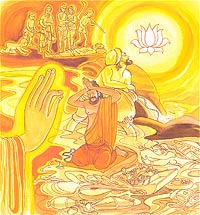
Verse 383. Be A Knower Of The Deathless
O brahmin, strive and cleave the stream,
desires of sense discarded,
knowing conditioned things decay
be Knower-of-the-Uncreated.
Explanation:
Exert all you can and cut off the stream of existence. Get rid of
passion. Get to know the erosion of the condition things. And, they
become the knower of the uncreated - Nibbana.
Exert all you can and cut off the stream of existence. Get rid of
passion. Get to know the erosion of the condition things. And, they
become the knower of the uncreated - Nibbana.
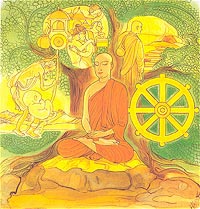
Verse 384. Cultivate Concentration
When by the twofold Dhamma
a Brahmin’s gone beyond
all the bonds of One-who-Knows
have wholly disappeared.
Explanation:
When the brahmana - the seeker after the truth - has understood the two
states of concentration and insight through and through, then in that
person who knows these, all fetters wane, diminish and fade away.
When the brahmana - the seeker after the truth - has understood the two
states of concentration and insight through and through, then in that
person who knows these, all fetters wane, diminish and fade away.
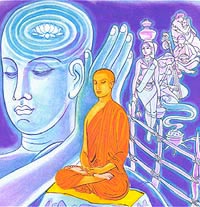
Verse 385. The Unfettered Person Is A Brahmana
For whom is found no near or far,
for whom’s no near or far,
free of fear and fetter-free,
that one I call a Brahmin True.
Explanation:
To him there is no further shore. To him there is no near shore. To him
both these shores are non-existent. He is free of anxiety and is freed
of bonds. That person I describe as a Brahmana.
To him there is no further shore. To him there is no near shore. To him
both these shores are non-existent. He is free of anxiety and is freed
of bonds. That person I describe as a Brahmana.
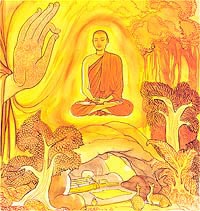
Verse 386. Who Is Contemplative And Pure Is A Brahmin
Seated stainless, concentrated,
who’s work is done, who’s free of taints,
having attained the highest aim,
that one I call a Brahmin True.
Explanation:
He is given to concentrated contemplation. He is free of all blemishes -
the dust that defiles a being. He sits in solitude. All his spiritual
tasks and obligations are done. He has reached the highest goal. That
person I describe as a brahmana.
He is given to concentrated contemplation. He is free of all blemishes -
the dust that defiles a being. He sits in solitude. All his spiritual
tasks and obligations are done. He has reached the highest goal. That
person I describe as a brahmana.
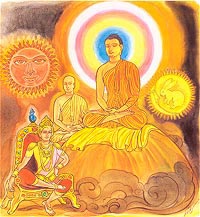
Verse 387. The Buddha Shines Day And Night
The sun is bright by day,
the moon enlights the night,
armoured shines the warrior,
contemplative the Brahmin True.
But all day and night-time too
resplendent does the Buddha shine.
Explanation:
The sun shines during the day. The moon beams at night. The warrior
glows only when he has his armour on. The brahmana shines when he is
concentrated on contemplation. All these people have various times to
shine. But the Buddha is radiant all day and all night through his
Enlightenment.
The sun shines during the day. The moon beams at night. The warrior
glows only when he has his armour on. The brahmana shines when he is
concentrated on contemplation. All these people have various times to
shine. But the Buddha is radiant all day and all night through his
Enlightenment.
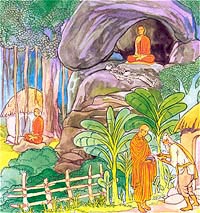
Verse 388. He Who Had Discarded All Evil Is Holy
By barring-out badness a ‘brahmin’ one’s called
and one is a monk by conduct serene,
banishing blemishes out of oneself
therefore one’s known as ‘one who has left home’.
Explanation:
One who has got rid of sinful action is called brahmana. One of serene
senses is called samana. A person is called pabbajita because he has
done away with all his faults.
One who has got rid of sinful action is called brahmana. One of serene
senses is called samana. A person is called pabbajita because he has
done away with all his faults.
Note:
brahmano, samano, pabbajito: a brahmin, a monk a wandering ascetic.
These are all categories of priests in the religious landscape of the
Buddha’s day. They pursued a multitude of religious paths. Here the
Buddha explains who a real priest, monk or a brahmin is.
brahmano, samano, pabbajito: a brahmin, a monk a wandering ascetic.
These are all categories of priests in the religious landscape of the
Buddha’s day. They pursued a multitude of religious paths. Here the
Buddha explains who a real priest, monk or a brahmin is.
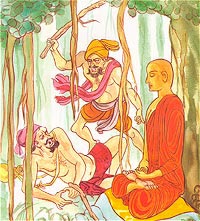
Verse 389. Harm Not An Arahat
One should not a brahmin beat
nor for that should He react.
Shame! Who would a Brahmin beat,
more shame for any should they react.
Explanation:
No one should strike a brahmana - the pure saint. The brahmana who has
become a victim must refrain from attacking the attacker in return, or
show anger in return. Shame on him who attacks a brahmana; greater shame
on him who displays retaliatory anger.
No one should strike a brahmana - the pure saint. The brahmana who has
become a victim must refrain from attacking the attacker in return, or
show anger in return. Shame on him who attacks a brahmana; greater shame
on him who displays retaliatory anger.

Verse 390. An Arahat Does Not Retaliate
For brahmin no small benefit
when mind’s aloof from what is dear.
As much he turns away from harm
so much indeed does dukkha die.
Explanation:
To the brahmana, the act of not returning hate is not a minor asset -
it is a great asset, indeed. If, there is in a mind which usually takes
delight in hateful acts, there is a change for the better, it is not a
minor victory. Each time the violent mind ceases, suffering, too,
subsides.
To the brahmana, the act of not returning hate is not a minor asset -
it is a great asset, indeed. If, there is in a mind which usually takes
delight in hateful acts, there is a change for the better, it is not a
minor victory. Each time the violent mind ceases, suffering, too,
subsides.
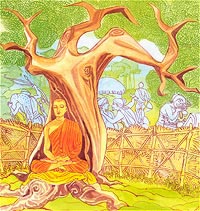
Verse 391. The Well-Restrained Is Truly A Brahmin
In whom there is no wrong-doing
by body, speech or mind,
in these three ways restrained,
that one I call a Brahmin True.
Explanation:
If an individual is well guarded in body, speech and in mind, and has
done no wrong in these three areas, who is well restrained, I call that
person a true brahmana - the noble saint.
If an individual is well guarded in body, speech and in mind, and has
done no wrong in these three areas, who is well restrained, I call that
person a true brahmana - the noble saint.
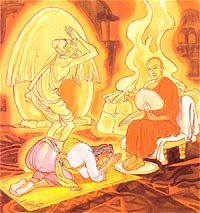
Verse 392. Honour To Whom Honour Is Due
From whom one knows the Dhamma
by Perfect Buddha taught
devoutly one should honour them
as brahmin sacred fire.
Explanation:
If a seeker after truth were to learn the Word of the Enlightened One
from a teacher, that pupil must pay the Teacher due respect, like a
brahmin paying homage assiduously and with respect to the sacrificial
fire.
If a seeker after truth were to learn the Word of the Enlightened One
from a teacher, that pupil must pay the Teacher due respect, like a
brahmin paying homage assiduously and with respect to the sacrificial
fire.
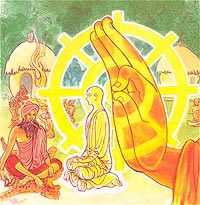
Verse 393. One Does Not Become A Brahmin Merely By Birth
By birth one is no brahmin,
by family, austerity.
In whom are truth and Dhamma too
pure is he, a Brahmin’s he.
Explanation:
One does not become a brahmin by one’s matted hair. Nor does one become
a brahmin by one’s clan. Even one’s birth will not make a brahmin. If
one has realized the Truth., has acquired the knowledge of the Teaching,
if he is also pure, it is such a person that I describe as a brahmin.
One does not become a brahmin by one’s matted hair. Nor does one become
a brahmin by one’s clan. Even one’s birth will not make a brahmin. If
one has realized the Truth., has acquired the knowledge of the Teaching,
if he is also pure, it is such a person that I describe as a brahmin.
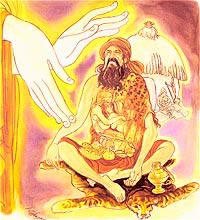
Verse 394. Be Pure Within
What’s the coiled hair for?
For what your cloak of skins?
Within you are acquisitive,
you decorate without.
Explanation:
Of what use are your exterior sights of asceticism: you matted hair,
your leopard skin garment? Your outside you keep clean and bright, while
inside you are filled with defilements.
Of what use are your exterior sights of asceticism: you matted hair,
your leopard skin garment? Your outside you keep clean and bright, while
inside you are filled with defilements.
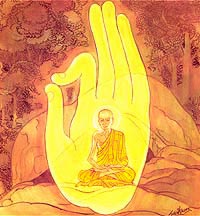
Verse 395. Who Meditates Alone in the Forest Is A Brahmana
One enduring rag-robes, lean,
with body o’er spread by veins,
lone in the woods who meditates,
that one I call a Brahmin True.
Explanation:
He wears robs made of cast off rags. He is so austere and lean that
veins stand out in his body. All alone, he meditates in the forest. Such
a seeker if truth, I describe as a brahmano.
He wears robs made of cast off rags. He is so austere and lean that
veins stand out in his body. All alone, he meditates in the forest. Such
a seeker if truth, I describe as a brahmano.
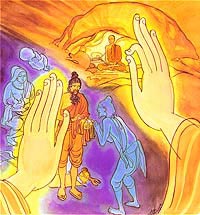
Verse 396. Non-Possessive And The Non-Attached Person Is A Brahmana
I call him a brahmin though
by womb-born mother’s lineage,
he’s just supercilious
if with sense of ownership,
owning nothing and unattached:
that one I call a Brahmin True.
Explanation:
I would not call a person a brahmana merely because he was born out of a
brahmana mother’s womb. Nor would I call a person a brahmin merely
because he goes about addressing people as sir. These people are full of
defilements. I call a person a brahmin who is free of faults and is not
given to craving.
I would not call a person a brahmana merely because he was born out of a
brahmana mother’s womb. Nor would I call a person a brahmin merely
because he goes about addressing people as sir. These people are full of
defilements. I call a person a brahmin who is free of faults and is not
given to craving.
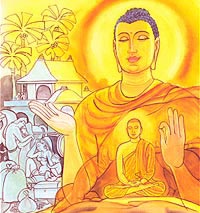
Verse 397. A Brahmana Is He Who Has Destroyed All Fetters
Who fetters all has severed
does tremble not at all,
who’s gone beyond all bond, unyoked,
that one I call a Brahmin True.
Explanation:
He has got rid of all fetters; in consequence, he is free of
trepidation and is fearless. He has travelled beyond all bonds.
Disengaged from bonds, he is no longer tied to the world. Such a person I
describe as a brahmana.
He has got rid of all fetters; in consequence, he is free of
trepidation and is fearless. He has travelled beyond all bonds.
Disengaged from bonds, he is no longer tied to the world. Such a person I
describe as a brahmana.

Verse 398. A Brahmana Is He Who Has No Hatred
When cutting strap and reins,
the rope and bridle too,
tipping the shaft, he’s Waked,
that one I call a Brahmin True.
Explanation:
He has got rid of the strap of ill-will. He has freed himself from the
thong of craving. He has escaped the large shackle breaking all its
links. These are the false views that curb the people. He has taken off
the cross-bar of ignorance. He has become aware of the four noble
truths. That person, I describe as a brahmana.
He has got rid of the strap of ill-will. He has freed himself from the
thong of craving. He has escaped the large shackle breaking all its
links. These are the false views that curb the people. He has taken off
the cross-bar of ignorance. He has become aware of the four noble
truths. That person, I describe as a brahmana.
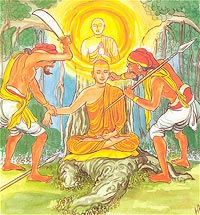
Verse 399. A Brahmana Is He Who Is Patient
Who angerless endures abuse.
Beating and imprisonment,
with patience’s power, an armed might:
that one I call a Brahmin True.
Explanation:
He is abused and insulted. He is tortured, imprisoned and bound up. But
he endures all these without being provoked or without losing his
temper. Such an individual who has patience as his power and his army, I
describe as a true brahmano.
He is abused and insulted. He is tortured, imprisoned and bound up. But
he endures all these without being provoked or without losing his
temper. Such an individual who has patience as his power and his army, I
describe as a true brahmano.
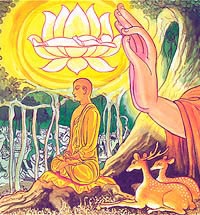
Verse 400. A Brahmana Is He Who Is Not Wrathful
Who’s angerless and dutiful,
of virtue full and free of lust,
who’s tamed, to final body come,
that one I call a Brahmin True.
Explanation:
He is free of anger. He carefully performs his religious duties and is
mindful of the observances. He is disciplined in terms of virtuous
behaviour. He is restrained. This is the final body he will occupy as he
has ended his cycle of births. I call that person a brahmana.
He is free of anger. He carefully performs his religious duties and is
mindful of the observances. He is disciplined in terms of virtuous
behaviour. He is restrained. This is the final body he will occupy as he
has ended his cycle of births. I call that person a brahmana.
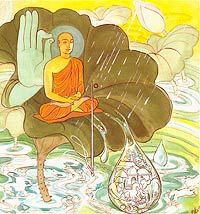
Verse 401. He Is A Brahmana Who Clings Not To Sensual Pleasures
Like water on a lotus leaf,
or mustard seed on needle point,
whoso clings not to sensual things,
that one I call a Brahmin True.
Explanation:
The water does not get attached to the surface of the lotus leaf. The
mustard seed does not get attached to the point of a needle. In the same
way, the wise one’s mind does not get attached to sensual pleasure.
Such a non-attached person I describe as the true brahmana .
The water does not get attached to the surface of the lotus leaf. The
mustard seed does not get attached to the point of a needle. In the same
way, the wise one’s mind does not get attached to sensual pleasure.
Such a non-attached person I describe as the true brahmana .
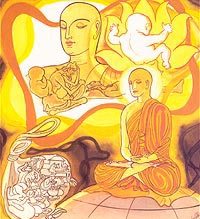
Verse 402. A Brahmana Is He Who Has Laid The Burden Aside
Whoso in this world comes to know
cessation of all sorrow,
laid down the burden, freed from bonds,
that one I call a Brahmin True.
Explanation:
He has become aware, in this world itself, the end of suffering. He is
unburdened: he has put down the load. He has got disengaged from the
bonds that held him. I call that person a true brahmana.
He has become aware, in this world itself, the end of suffering. He is
unburdened: he has put down the load. He has got disengaged from the
bonds that held him. I call that person a true brahmana.
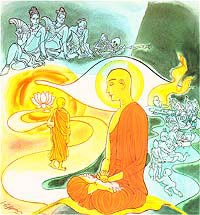
Verse 403. A Brahmana Is He Who Has Reached His Ultimate Goal
Whose knowledge is deep, who’s wise,
who’s skilled in ways right and wrong,
having attained the highest aim,
that one I call a Brahmin True.
Explanation:
He possesses profound wisdom. He is full of insight. He is capable of
discriminating the right path from the wrong path. He has reached the
highest state. I call that person a true brahmana.
He possesses profound wisdom. He is full of insight. He is capable of
discriminating the right path from the wrong path. He has reached the
highest state. I call that person a true brahmana.
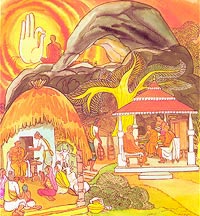
Verse 404. A Brahmana Is He Who Has No Intimacy With Any
Aloof alike from laity
and those gone forth to homelessness,
who wanders with no home or wish,
that one I call a Brahmin True.
Explanation:
He does not establish extensive contact either with laymen or with the
homeless. He is not attached to the way of life of the householder. He
is content with the bare minimum of needs. I call that person a true
brahmana.
He does not establish extensive contact either with laymen or with the
homeless. He is not attached to the way of life of the householder. He
is content with the bare minimum of needs. I call that person a true
brahmana.
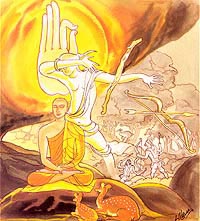
Verse 405. A Brahmana Is He Who Is Absolutely Harmless
Who blows to beings has renounced
to trembling ones, to bold,
who causes not to kill nor kills,
that one I call a Brahmin True.
Explanation:
He has discarded the rod and set aside the weapons. He does not hurt
neither the frightened, timid beings, nor stubborn, fearless beings. I
call that person a brahmana.
He has discarded the rod and set aside the weapons. He does not hurt
neither the frightened, timid beings, nor stubborn, fearless beings. I
call that person a brahmana.
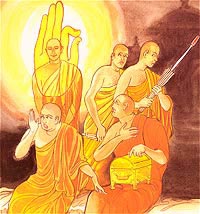
Verse 406. A Brahmana Is He Who Is Friendly Amongst The Hostile
Among the hostile, friendly,
among the violent, cool
detached amidst the passionate,
that one I call a Brahmin True.
Explanation:
Being friendly even among the hostile. Free from hostility, violence
and passionate grasping, one emerges a true brahmin.
Being friendly even among the hostile. Free from hostility, violence
and passionate grasping, one emerges a true brahmin.
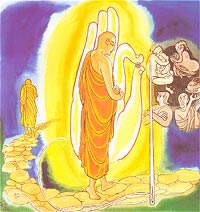
Verse 407. A Brahmana Is He Who Has Discarded All Passions
From whomever lust and hate,
conceit, contempt have dropped away,
as mustard seed from a point of a needle,
that one I call a Brahmin True.
Explanation:
His mind does not accept such evils as lust, ill-will, pride and
ingratitude. In this, his mind is like a point of a needle that just
does not grasp a mustard seed. An individual endowed with such a mind I
describe as a brahmana.
His mind does not accept such evils as lust, ill-will, pride and
ingratitude. In this, his mind is like a point of a needle that just
does not grasp a mustard seed. An individual endowed with such a mind I
describe as a brahmana.
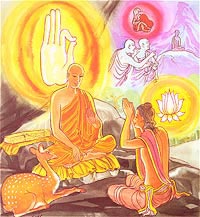
Verse 408. A Brahmana Is He Who Gives Offence To None
Who utters speech instructive,
true and gentle too,
who gives offence to none,
that one I call a Brahmin True.
Explanation:
His speech is true. His words are well-meaning, constructive and not
harsh. By his words he will not give offence to anyone. Nor will his
words provoke people. Such a person I declare a true brahmana.
His speech is true. His words are well-meaning, constructive and not
harsh. By his words he will not give offence to anyone. Nor will his
words provoke people. Such a person I declare a true brahmana.
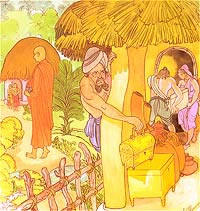
Verse 409. A Brahmana Is He Who Steals Not
Who in the world will never take
what is not given, long or short,
the great or small, the fair or foul,
that one I call a Brahmin True.
Explanation:
In this world if there is some person who does not take anything that
is not given, whether long or short, minute or large or good or bad, him
I declare a true brahmana.
In this world if there is some person who does not take anything that
is not given, whether long or short, minute or large or good or bad, him
I declare a true brahmana.
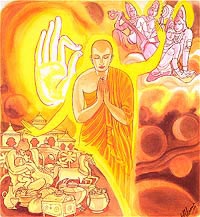
Verse 410. A Brahmana Is He Who Is Desireless
In whom there are no longings found
in this world or the next,
longingless and free from bonds,
that one I call Brahmin True.
Explanation:
He has no yearnings either for this world or for the next. He is free
from earning and greed. He is disengaged from defilements. Such a person
I declare a fine brahmana.
He has no yearnings either for this world or for the next. He is free
from earning and greed. He is disengaged from defilements. Such a person
I declare a fine brahmana.
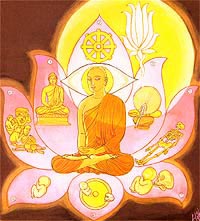
Verse 411. In Whom There Is No Clinging
In whom there is no dependence found,
with Final Knowledge freed from doubt,
who’s plunged into the Deathless depths,
that one I call a Brahmin True.
Explanation:
He has no attachments - no attachments can be discovered in him. He has
no spiritual doubts due to his right awareness, He has entered the
deathless - Nibbana. I describe him, a true brahmana.
He has no attachments - no attachments can be discovered in him. He has
no spiritual doubts due to his right awareness, He has entered the
deathless - Nibbana. I describe him, a true brahmana.
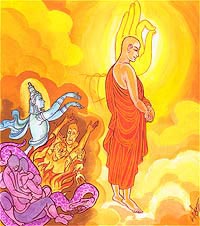
Verse 412. Above Both Good And Evil
Here who’s gone beyond both bonds
to goodness and evil too,
is sorrowless, unsullied, pure
that one I call a Brahmin True.
Explanation:
If any person in this world has travelled beyond both good and the bad,
and the attachments, and if he is without sorrow, and is bereft of
blemishes, and is pure, him I describe as a true brahmana.
If any person in this world has travelled beyond both good and the bad,
and the attachments, and if he is without sorrow, and is bereft of
blemishes, and is pure, him I describe as a true brahmana.
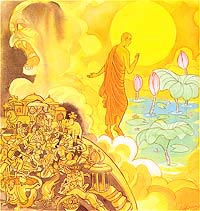
Verse 413. Learning The Charm
Who, like the moon, unblemished, pure,
is clear and limpid, and in whom
delights in being a consumed,
that one I call a Brahmin True.
Explanation:
He is like the moon at the full - spotless and free of blemishes. He is
pure, calm, serene and exceptionally tranquil. He is has got rid of the
craving that takes delight in the cycle of existence. That person I
declare a true brahmana.
He is like the moon at the full - spotless and free of blemishes. He is
pure, calm, serene and exceptionally tranquil. He is has got rid of the
craving that takes delight in the cycle of existence. That person I
declare a true brahmana.
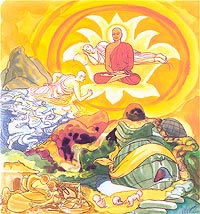
Verse 414. The Tranquil Person
Who’s passed this difficult path,
delusion’s bond, the wandering-on,
who’s crossed beyond , contemplative,
uncraving with no questioning doubt,
no clinging’s fuel so cool become,
that one I call a Brahmin true.
Explanation:
He has crossed over the quagmire of passion. He has gone beyond the
difficult terrain of blemishes, that is hard to traverse and has crossed
the cycle of existence. He is fully and totally reached the other
shore. He is a meditator and is bereft of craving. His spiritual doubts
are resolved. He is no longer given to grasping. He is cooled. Such a
person I describe as a true brahmana.
He has crossed over the quagmire of passion. He has gone beyond the
difficult terrain of blemishes, that is hard to traverse and has crossed
the cycle of existence. He is fully and totally reached the other
shore. He is a meditator and is bereft of craving. His spiritual doubts
are resolved. He is no longer given to grasping. He is cooled. Such a
person I describe as a true brahmana.
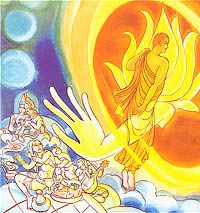
Verse 415. Freed From Temptation
Who has abandoned lusting here
as homeless one renouncing all,
with lust and being quite consumed,
that one I call a Brahmin True.
Explanation: Rejecting pleasure, homeless he goes to life’s journey’s end. Him, I call a Brahmin True.
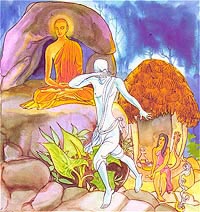
Verse 416. The Miracle Rings
Who has abandoned lusting here
as homeless one renouncing all,
with lust and being quite consumed,
that one I call a Brahmin True.
Explanation:
In this world, he has taken to the life of a wandering ascetic. He has
got rid of the craving to continue the cycle of existence. I describe
that person as a true brahmana.
In this world, he has taken to the life of a wandering ascetic. He has
got rid of the craving to continue the cycle of existence. I describe
that person as a true brahmana.
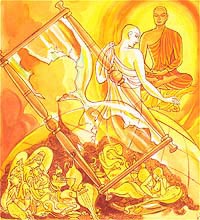
Verse 417. Beyond All Bonds
Abandoned all human bonds
and gone beyond the bonds of gods,
unbound one is from every bond,
that one I call a Brahmin True.
Explanation:
He has given up the bonds that bind him to humanity. He has gone beyond
the bonds of attachment to life in heaven as well. This way, he is
disengaged from all bonds. I declare such a person a brahmana.
He has given up the bonds that bind him to humanity. He has gone beyond
the bonds of attachment to life in heaven as well. This way, he is
disengaged from all bonds. I declare such a person a brahmana.
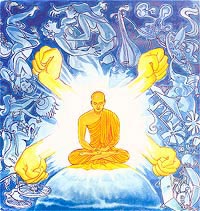
Verse 418. The Person Whose Mind Is Cool
Abandoned boredom and delight,
become quite cool and assetless,
a hero, All-worlds-Conqueror,
that one I call a Brahmin True.
Explanation:
He has given up lust. He has also given up his disgust for the practice
of meditation. This way, he is both lustful and lustres. He has
achieved total tranquillity. He is devoid of the blemishes that soil the
hand. He has conquered all the world and is full of effort. I call that
person a brahmana.
He has given up lust. He has also given up his disgust for the practice
of meditation. This way, he is both lustful and lustres. He has
achieved total tranquillity. He is devoid of the blemishes that soil the
hand. He has conquered all the world and is full of effort. I call that
person a brahmana.
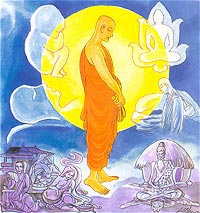
Verse 419. Diviner Of Rebirth
Who knows how clutching creatures die
to reappear in many a mode,
unclutching then, sublime, Awake,
that one I call a Brahmin True.
Explanation:
He knows the death and birth of beings in every way. He is not attached
to either birth or death. He has arrived at the proper destination. He
possesses the knowledge of the essences. This person I describe as a
brahmana.
He knows the death and birth of beings in every way. He is not attached
to either birth or death. He has arrived at the proper destination. He
possesses the knowledge of the essences. This person I describe as a
brahmana.
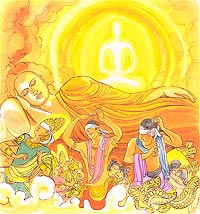
Verse 420. Destroy Unknown
Whos destination is unknown
to humans, spirits or to gods,
pollutions stayed, an Arahant,
that one I call a Brahmin True.
Explanation:
Their path, neither gods, nor spirits, nor humans can fathom. Their
taints are totally eradicated. They have attained the higher spiritual
state. This person I declare a brahmana.
Their path, neither gods, nor spirits, nor humans can fathom. Their
taints are totally eradicated. They have attained the higher spiritual
state. This person I declare a brahmana.
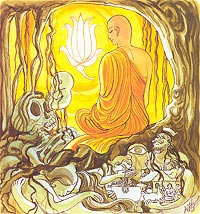
Verse 421. He Yearns For Nothing
That one who’s free of everything
that’s past, that’s present, yet to be,
who nothing owns, who’s unattached,
that one I call a Brahmin True.
Explanation:
Their path, neither gods, nor spirits, nor humans can fathom. Their
taints are totally eradicated. They have attained the higher spiritual
state. This person I declare a brahmana.
Their path, neither gods, nor spirits, nor humans can fathom. Their
taints are totally eradicated. They have attained the higher spiritual
state. This person I declare a brahmana.
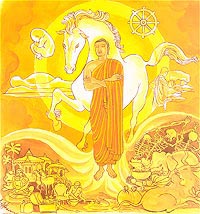
Verse 422. He Who Is Rid Of Defilements
One noble, most excellent, heroic too,
great sage and one who conquers all,
who’s faultless, washed, one Awake,
that one I call a Brahmin True.
Explanation:
He is a great sage as he has realized the essentials. He has conquered
death. He is devoid of blemishes. He has washed away all evil. He has
awakener to the essentials. That person, I describe as a brahmana.
He is a great sage as he has realized the essentials. He has conquered
death. He is devoid of blemishes. He has washed away all evil. He has
awakener to the essentials. That person, I describe as a brahmana.
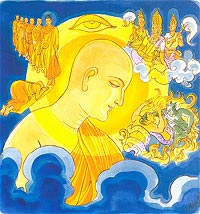
Verse 423. The Giver And Receiver Of Alms
Who so does know of former lives
and sees the states of bliss and woe
and then who’s reached the end of births,
a sage supreme with wisdom keen,
complete in all accomplishments,
that one I call a Brahmin True.
Explanation:
He knows his former existences. He has the capacity to see heaven and
hell - states of ecstasy and states of woe. He has ended the cycle of
existences. He has his higher awareness. He has reached the state of a
sage. He has achieved the final perfection. Him I describe as a
brahmana.
He knows his former existences. He has the capacity to see heaven and
hell - states of ecstasy and states of woe. He has ended the cycle of
existences. He has his higher awareness. He has reached the state of a
sage. He has achieved the final perfection. Him I describe as a
brahmana.












![Narasīha Gâthâ - [The Stanzas On The Lion of Men]🙏🙏🙏💓](https://external.fblr15-1.fna.fbcdn.net/safe_image.php?d=AQGViBcy_WT5hG11&w=500&h=261&url=https%3A%2F%2Fi.ytimg.com%2Fvi%2FqXyupCEIJuc%2Fmaxresdefault.jpg&cfs=1&sx=0&sy=17&sw=1280&sh=668&ext=jpg&_nc_oe=6ed79&_nc_sid=632586&ccb=3-5&_nc_hash=AQG9CZeyZUmnjTNO)